
Introduction
In 1939, 184 destroyers were in service, dating back for a large part from 1917-18, in particular the large V-W classes, some destroyers leaders, and interwar vessels, from the “A” class to the “Battle” class. It would take too long to detail the career of all ships from all these classes of destroyers built since 1920, and those from the Great War. They had an almost an identical configuration since the Shakespeare and Scott class flotilla leaders entered the fray in 1917-1920. At that time, the armament of these leaders included five 5-in, three 3-in AA guns and 2-pdr, and six torpedo tubes, of the standard 21 in (533 mm) in two triple axial banks amidships. The V-W “standard” classes led by those above were significantly heavier than the previous R, but had four 4-in (102 mm) and four torpedo tubes only, with 500 tonnes less. The practice of having “standard” leaders and destroyers was not unique to the Royal Navy, and it for some years until 1930.
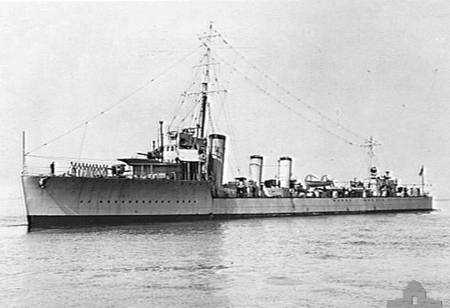
HMAS Anzac, of the Parker class Flotilla Leaders (1915). They were broken up in 1936.
After that, tactics changed and the destroyers reached a much higher standard: By 1939-40, the J/K/N class constituted a clear advance, had a displacement of 2500 tonnes at full load (against 2,000 for the leaders of 1918), six 5-in (120 mm) in twin mounts, 10 torpedo tubes in quintuple banks and a significantly larger AA. As a result, destroyers dating from before 1920 were essentially converted as ASW escorts.

HMS Havant in 1940 (1/750), when it entered service.
Characteristics of British Destroyers
In addition to WW1 models, interwar British destroyers went on the same path of standard models for serial production, and large, well armed, powerful and well equipped leaders, to lead British destroyer flotillas with for the admiralty the aim to construct a flotilla each year. The standard ones were developed from V and W-class classes and they progressed steadily, but when the flotilla leaders stopped, aside the standards a nw kind of heavy destroyer was attempted in 1937 with the tribal class, which was near-imitated again in 1944-45 with the Battle class. Destroyers stayed relatively similar on the long run, only increasing in size and complexity but the design became simplified and cheaper to produce. Soon experience led to increase AA and ASW capabilities, through conversions within the War Emergency Programme. A few destroyers were also built in the Commonwealth, mostly Canadian and Australian versions of the Tribal, like the famous HCMS Haida, now preserved.
British destroyer design, stayed remarkably constant despite incremental changes, the exceptional Tribal-class, and an attempt to produce the more complex, larger and costier J, K and N classes, Ls and Ms, before a return to the simpler War Emergency Programme design.
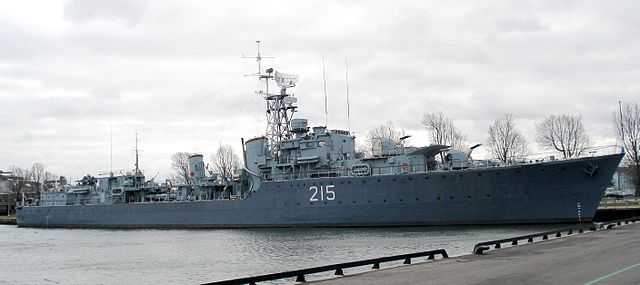
HCMS Haida, a late war Canadian version of the Tribal, as preserved in Ontario.
Hull and propulsion
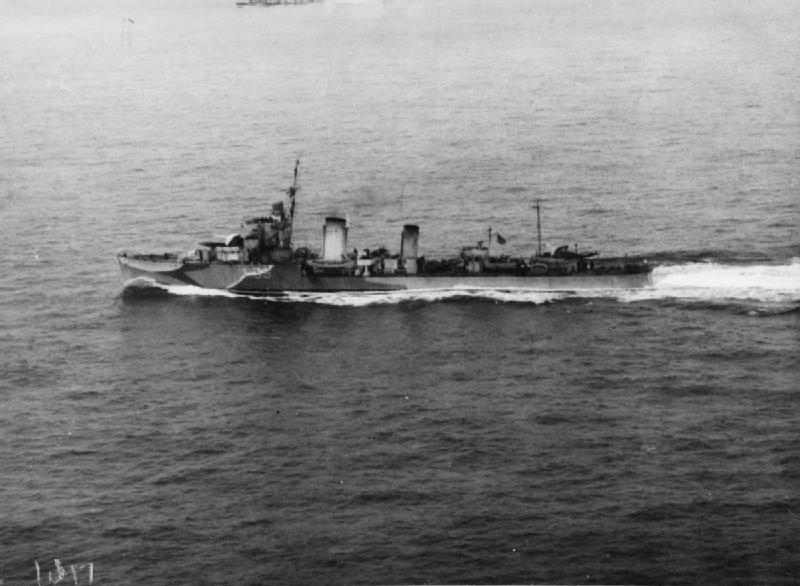
HMS Amazon at full speed in 1942 – iwmcollections.org.uk
This area shows little improvement over the years at least in general shape. The classic forecastle type appeared with the 1903 River class destroyers, and never really evolved since. The base model for WW2 destroyer was the WW1 destroyer leader model of the Scott class, which setup the basic British hull design for the years to come. The forecastle represented about 40% of the total length, the fore section crowded by the bridge and main mast, super-firing shielded gun N°2 and deck level N°1, while the aft section made room for a running platform on top of which were placed the two funnels, and air intakes, access to the boiler room. Just after came the torpedo tubes, for long, triple (see later), and aft guns on the quarterdeck room, plus the aft mast. The prow was generally slightly raked, the stern rounded. This started to change with the 1936 Tribal, which inaugurated twin guns mounts, and a clipper bow. Single mast and single funnel with a slightly more raked bow started to appear with the “J” class in 1938. Transom stern appeared in 1942 with the “Q” class, simplifying construction and helping clear off the depth charges in racks. Due to the increase size and width as well, more AA could be added (see later). Displacement rose from the HMS Amazon (A class preserie, 1926) at 1352 tonnes standard to 1720 on the ‘Tribals’ or 1770 on the J-K-N class up to 2400 on the late serie Battle class (completed postwar).
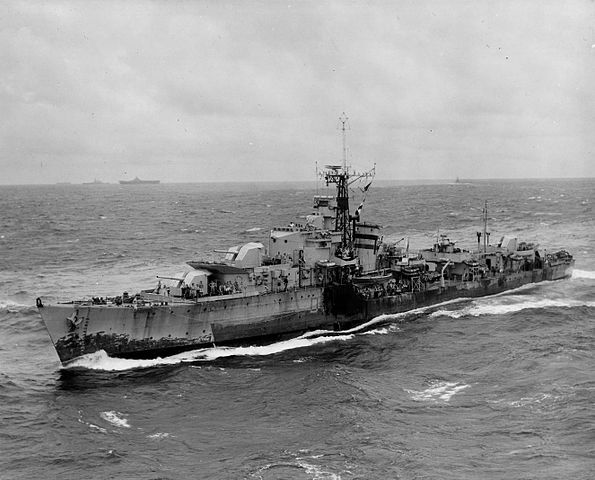
British T-class destroyer, 1945. See a colorized HD version made for the daily mail by Jared Enos
propulsion-wise, the setup was also made by the WWI flotilla leaders: The Scotts had two shaft IR geared steam Turbines, 4 Yarrow boilers, with a total output on the Scott (1917) of 40,000 shp, enough for 26 knots, burning oil only. They were twice as powerful compared to the 1917 V-W, the 1100 tonnes admiralty design (27,000 shp, 34 knots). The A-B class of 1929 had two shafts geared turbines of various manufacturers coupled with three admiralty 3-drum boilers, for an output of 34,000 hp, less than the WWI leaders, but it was more than sufficient to give them 35.25 knots (37 on HMS Amazon and Ambuscade, the prototypes). This power will gradually increase until the wartime J-K-N class to 40,000 shp for 36 knots, turbines being invariably from Parsons and the boilers, two admiralty 3-drum models. The Tribals were a bit off the map here, propelled by two turbines fed by three boilers of the same type, for 44,000 shp, achieving more than 36 knots. They also carried more oil due to the larger hull. Of course the 1943 Battle class was one step further with two larger boilers of the same type giving an output of 50,000 shp, enough to reach 35.75 knots. The admiralty indeed never was interested in achieving 40+ knots speed as French destroyers, and there were reasons for this: Standardization, and the heavy weather of the north sea which prevented to reach these high speeds anyway, only useful on the Mediterranean.
Armament: Guns and AA
Main Guns
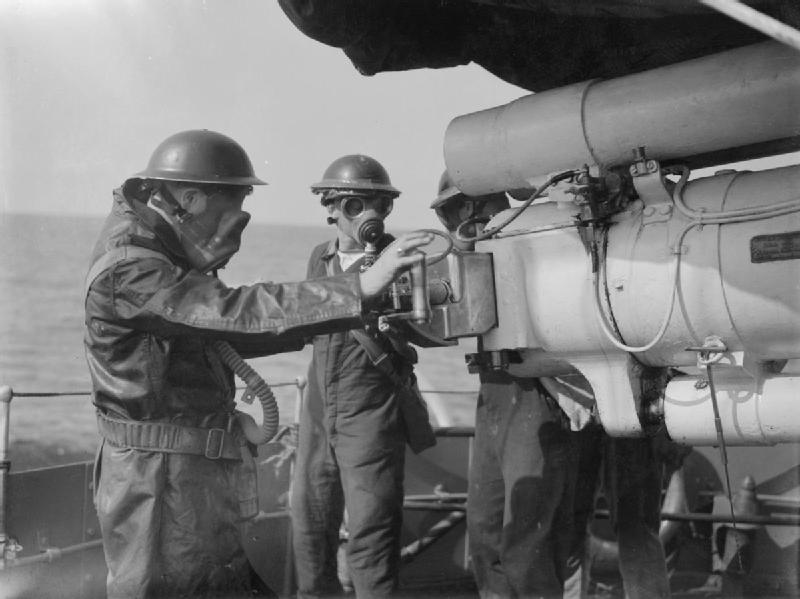
BL 4.7 in gun on HMS Broke, IWM
– QF 4.7 inch – standard main battery gun replaced later by the QF dual purpose 4.5 inch in 1942. No HA version. This was a powerful gun when introduced, and became the ubiquitous artillery for the majority of British Destroyers during WWII.
The original 4.7″ (12 cm) BL Mark I was introduced on the Scott, Shakespeare and Modified V&W classes of 1917-18, in response of the Germans having some destroyers armed with 15 cm (5.9″) guns. It was made of a tapered inner A tube, a full length wire with breech ring and breech bush, interchangeable. They also had a Welin breech block with Vickers mechanism. In total 776 were ordered but only 187 Mark I and Mk I* were completed before cancellation, of which 176 were still in service by 1939, although worn out. These guns also equipped the HMS Amazon and Ambuscade. From 1943 they started to be recycled on smaller ships. The British ordnance however instead of just reboring these WWI guns preferred to develop a brand new one, the Mark II. 32 Mark II were ordered in 1940, with a full length jacket and monobloc barrel.
Also equipped by these were the Athene and Engadine aircraft transports, LCG(L)3 and LCG(L), and the the French destroyers Mistral and Ouragan under British control, as rearmed. A few surviving ships of the smaller R, T and S classes of WWI still had the 4-in (102 mm). No info on the Mark III, probably experimental.
The 4.7 in/45 QF Mark IV was used on the A and B class interwar destroyers, the Mark IX on HMS Codrington (DD leader), C and D, E and F class destroyers and their leaders, G, H, I classes, the ex-Turkish DDs requisitioned (Ithuriel class), ex-Brazilian class requisitioned (Harvester class), and G, H, I class leaders (1935), but also the Q and R class and S,T,U,V classes of 1942.
In 1937 was introduced the Mark XII, adopted on the J ,K, N classes or wartime destroyers in twin mounts. The L and M classes used a longer barrel version, the Mark XI 50 caliber in three twin mount, used exclusively by the L and M class (1940-42)
– QF 4.5 inch The pre-war improvement over the 4.7 in: It existed in AP and HA versions and its mounting allowing AA fire. Smaller caliber but heavier shell, also 45 barrel lenght. It was less frequent on British destroyers, as the Mark IV was used on the Savage, Z, Ca, Ch, Co and Cr classes, the Battle class and Tribal class with Rebuilt Mark V mountings postwar.
But it was also used with fuses on many ships: The carriers Ark Royal (1937) and Illustrious class, the Forth, Maidstone supply ships, and the battleships Queen Elizabeth, Valiant and Renown as modernized (Mk.II and Mk.III), but also some monitors, the Mark III equipped the carrier HMS Implacable, HMS Savage, and the destroyers of the Battle 1942 and Battle 1943 classes but also postwar the carrier Eagle (1951) and Ark Royal (1955). RPM ranged from 12 to 15. They could fire the SAP 58.25 lbs. (23.0 kg), also the approximate Barrel Life was 650 rounds and provision for the Battle class was around 300 rounds, probably less on the Z, Ca, Ch, Co and Cr classes.
– QF 4 inch Mk V – World War I dual-purpose gun and coastal defence gun:
This model was intended to be used as a Dual Purpose (DP) weapon, and was a reasonably good AAA gun but lacked punch in anti-ship role, even against small vessels. It replaced the 4″/45 (10.2 cm) Mark V HA gun common on Cruisers. Some destroyers were rearmed as AA ships with twin masked mounts, four of them, of the L and M classes. however they were critiicized both for their barrel life and poor accuracy, according to John Campbell, blamed on projectiles with poor centering at the muzzle. The Mark XVI had an A tube and jacket from the muzzle and removable breech ring plus down-sliding breech block. Worked both on QF and Semi-Automatic mode, with different breech mechanism settings. Some 2,555 Mark XVI and XVI* guns and 238 Mark XXI were manufactured while Canada made 504 Mark XVI* and 135 Mark XXI guns and Australia 45 Mark XVI* guns, giving the scale of the effort. The QF 4 inch Mk XVI was superseded the earlier QF 4 inch Mk V. It was deployed on the “Hunt” and “Weapon” classes, the Canadian “Tribal” class, the “L” class destroyers as converted, HMS Lance, Legion, Lively and Gurkha, and “P” class destroyer HMS Petard, British “Tribal” class as converted as AA vessels and the Australian sloops HMAS Parramatta, Warrego, Bathurst and Kanimbla, plus many British sloops and auxiliary AA ships and ather vessels. The Polish also used it, the destroyer Blyskawica, completed and rearmed by the British.
– QF 6 pounder: Also called 6-pdr/10cwt or 2.244″/47 (57 mm) QF Mark I, it was usd by on some WWI era destroyers.
It was also developed as a coast defense gun by the Army to fire on E-boats and other small craft. Prototype tested in 1928, produced from 1934. 22 transferred to the Navy rearming WWI dstroyers. A tube, part length jacket, breech ring. Semi-automatic sliding breech block. Some were located in Valetta harbour. They managed to sink five Italian torpedo boats and Maiales (human torpedoes) in two minutes during the night attack of 25/26th July 1941, as being capable of 40 RPM from each barrel with good crews. Range was 11,300 yards (10,330 m) at 45° elevation.
– 3 in gun (lend-lease): US-built gun used on the 50 lend-lease destroyers transferred in 1940, see the US section. Sub-divided into the 3″/23.5 (7.62 cm) Marks 4 and 14, 7, 9, 11 and 13 and the 3″/50 (7.62 cm) Mark 10, 17, 18, 19, 20, 21 and 22.
AA Guns
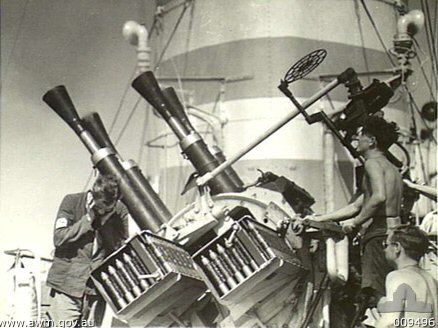
2-pdr ‘pom-pom’ on HMAS Parramatta
– QF 12 pdr: Used a a DP guns on early destroyers (WWI), also called 3″/45 (76.2 cm) or 20cwt QF HA. Declined into the Marks I, II, III and IV. It was Britain’s first designed-for-the-purpose AAA weapon, developed before WWI, widely used by the Navy and the Army. It had an A tube, full length wire, jacket, breech ring, and a vertical sliding breech-block with semi-automatic action. It was used on Destroyers of the “A” through “I” classes.
– QF 2 pounder (“pom-pom”): Quite ubiquitous, it was declined into many sub-variants: 2-pdr/50 [4 cm (1.75″) Mark IX and Mark X, 2-pdr/25 [4 cm (1.75″)] Mark XI, 2-pdr/39 [4 cm (1.75″)] Mark XII, and 2-pdr/50 [4 cm (1.75″) Mark XIV, but they were more common on HDML and Motor Launches. It was relatively short barrel and the Swedish Bofors was by far preferred.
– QF 40 mm (Bofors): The British water-cooled version was developed from the Dutch Hazemeyer mount in Britain in 1940, as seen on the Dutch minelayer Willem van der Zaan. The Black Swan class sloop HMS Whimbrel in November 1942 was the first to test it. Poduction combined in the Empire, UK, Australia and Canada is not accurately known in the range of about 2,800 plus those supplied from the US. 442 Mark IV and 342 Mark XI were in service by 1945 and 786 US-built at the same date.
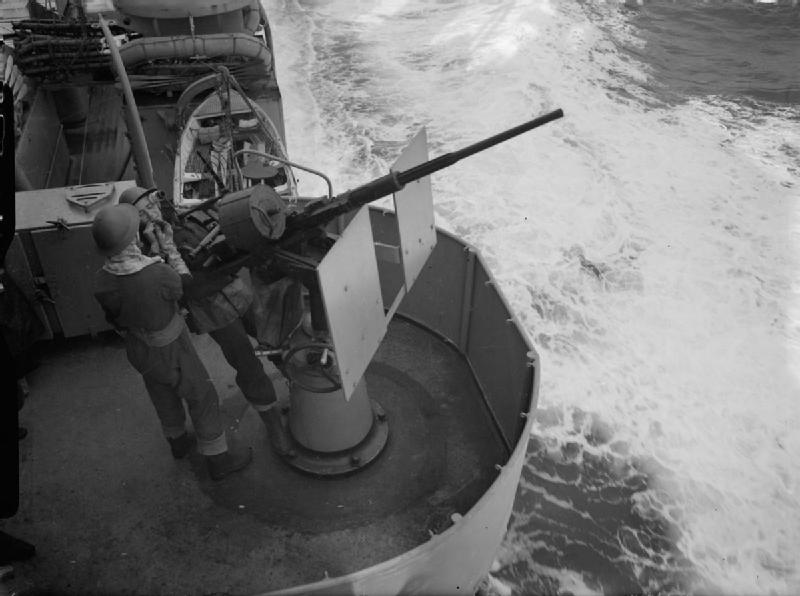
– QF 20 mm (Oerlikon): Production in UK started in Ruislip, London by the fall of 1940 from the Swiss model, purchased in 1938. The first produced were installed frim April 1941. It was superseded by Bofors 40/L60 40mm gun from 1943 in all three branches.
– QF 0.5 inch (Vickers) – mounted as an anti-aircraft weapon but, in practice quite ineffective.
– QF 0.303 (Lewis): Generally mounted in quad mount, tandem. Lacking punch against planes from the 1940s, but a very short range.
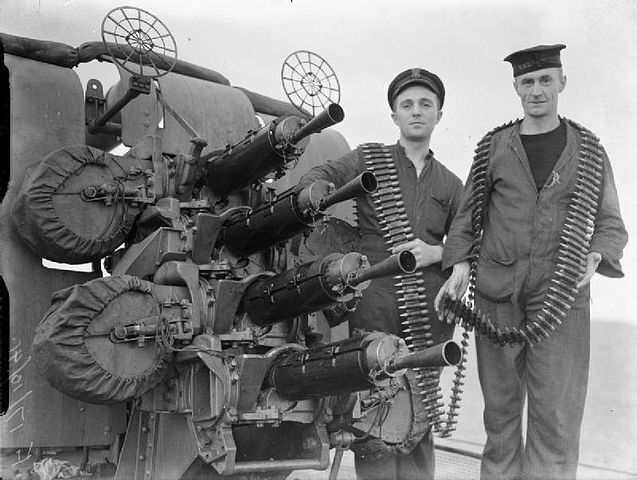
Armament: Torpedoes
Prewar models (flotilla leaders, V-W class): The 21 inches (53.3 cm) Mark IV and Mark IV*, Mark V were used. The latter were still used on A and B interwar destroyers. The latter dated back from 1918, powered by a wet-heater, weighting 3,828 lbs. (1,736 kg) for an overall Length of 23 ft 3 in (7.086 m) a range of 5,000 yards (4,570 m) at 40 knots or 13,500 yards/25 knots setting.
21 inch Mark IX (designed 1928): Fist deployed on the A class, and later models and used until the end of the war.
Characteristics: Weight 3,732 lbs. (1,693 kg) overall length 23 ft 10.5 in (7.277 m). Powered by a Burner-cycle engine providing 264 hp at 41 knots. Depending on the settings and models, the range was between 10,500 yards (9,600 m) at 36 knots to 15,000 yards (13,700 m) at 35 knots, but the double star could reach 41 knots (36 for older models). It was used in virtually all wartime emergency programme destroyers.
21 inch Mark X (1940): A peculiar model, it was known as the Mark X, X* models. However the Mark X was only used on Polish destroyers and the Mark X* on the ex-Brazilian Havant class destroyers. They were modified to fit these tubes and therefore produced in 1940-41 in small numbers. The latter carried a 661 lbs. (300 kg) TNT warhead and could reach 47 knots, but over 3,280 yards (3,000 m), extended to 13,120 yards (12,000 m) at 29 knots. They were propelled by a classic wet-heater, with four settings.
21 inch Mark XI (1944): This was the standard electric torpedo, inspired by captured German G7e-T2 torpedoes. Powered by electric batteries, this 3,632 lbs. (1,647 kg), 22 ft 5 in (6.833 m) long model carried a 710 lbs. (322 kg) TNT warhead to 5,500 yards (5,000 m) at 28 knots at max range as the motor produced 98 BHP at 1,755 rpm. Of course its main advantage was stealthiness, by not leaving a trail of bubbles. It was designed in particular for the crystal waters of the Mediterranean but found little use in 1944-45.
ASW Armament
Depth charges: These were of the Type A-B, C/C*, D/D*, D Mark III, Type E, F and Egerton model for WWI stocks. In 1940 was introduced the Mark VII Heavy, set for 91 m max (300 feets) and carrying a 290 Ibs. TNT charge. It was introduced in 1942. The British also testd magnetic fuses models, not adopted in service. There was also the torped-tubes launched Mark X, X*, X**. More on a dedicated post on British ASW vessels.
All in all, British ships (all types) thrown or droped 5,174 depth-charges for 85.5 confirmed kills, so a ratio of 60.8 DCs spent for each kill.
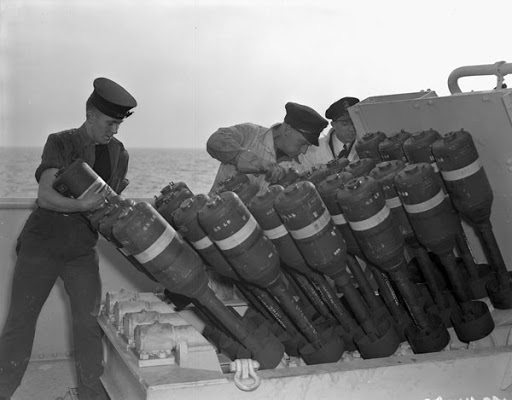
Early ASWRL models were tested, like the Fairlie Mortar, tested on HMS Whitehall in 1941 and HMS Diana in 1942. It consisted in five mortars for DCs mounted at the prow. The Parsnip was the former Fairlie Mortar redesigned as a ten-barrel model as a Plan B to back the Hedgehog. It was also unsuccessful.
Spigot mortar: Replacing the models above from 1942, but transitional as it was refined as the Hedgehog.
Hedgehog: Classic rocket-launcher (the first) introduced in 1942 but really efficient combined with a precise sonar in 1944.
Squid mortar: This 3-barrel, 12-in mortar was rushed into service in 1943 and tested on HMS Ambuscade. It was replaced by the Limbo.
Note: All these specific ASW weapons will be reviewed in greater detail in a future British ASW vessels article.
Radars, HFDF and SONAR:
Radars (The Polish and British were pioneers) were at first reserved to the largest ships, due to their weight essentially, but with time simpler, short range models found their way in destroyers from 1941. Their effectiveness against surface threats was prove time and again, giving a decisive advantage in night actions against the Italian Regia Marina notably, such as Cape Bon and Sfax. These were modified transmitters in the microwave portion of the radio spectrum and this low power 1st generation was installed in coastal centers, and played a vital part in the Battle of Britain. However in 1940, the invention of the resonant-cavity magnetron allowed to reduce components enough to fit the radar on any ship. Bell Labs soon duplicated it and perfected the model, which saw a wide use in USN service.
Inside the Navy, His Majesty’s Signal School (HMSS) made early demonstrations of previous experiments made at Orfordness and Bawdsey Manor, from Portsmouth, with the task of developing wireless valves used at Orford Ness. This led to an Admiralty RDF model, later developed at Witley and Haslemere in Surrey. In the end, this unit was integrated onto the Admiralty Signal Establishment (ASE).
The Royal Navy used numerous models, we will concentrate on those carried by destroyers: Surface Warning/Gun Control (Type 281), Air Search/Gunnery Director (Type 282-285), Microwave Warning/Fire Control (Type 271), the lighter of them all. The Type 272-273 were early models used on destroyers. The most common derivative of the Type 277 was the light Type 276 for destroyers. It replaced the first generation Type 271, considered internally as a failure because of its poor range and lack of accuracy. But it was given to corvettes and small ships, protected by a unique “lantern” radome, mounted directly over the radar operator’s cabin. Tested in March 1941 it consisted in a cavity magnetron and sealed crystal detectors, and really became powerful by 1944-45.
Huff-Duff:
Another electronic device widely used by Destroyers and smaller vessels for ASW detection was a simple antenna, the Huff-Duff. Its colloquial nickname came from its acronym HF/DF, standing for High-frequency direction finding. Its purpose was to intercept HF signals emitted by U-Boat radios to the HQ at Lorient. It became with the Sonar one of the strenghts of Allies intelligence, locating German U-boats and commerce raiders in the Atlantic.
ASV (fleet air arm):
Outside the Navy, the fleet air arm also receive its own model, the Air-Surface Vessel Mark I, using electronics similar to AI sets. It was the world’s first aircraft radar to enter service in early 1940. In 1942-43 it was gradually improved to the ASV Mk.II which power allowed to detect submarines on the surface.
Sonars:
This device went back to WWI, and it was perfected during the interwar, in power, accuracy and range. The ealiest ones were the Type 112 (1920) fitted to the V-W class destroyers. The Type 119 was introduced on the B class destroyers in 1930, and the Type 121 had the first retractable dome. It was first tested in 1931 and deployed on D, E, F, G class destroyers. The Type 124 appeared in 1934 and was a rectractable type, fitted on the C,H,I,J,K and Tribal class destroyers, and retrofitted as well in WWI era and interwar models. The smaller Type 128, first tested on HMS Acheron in 1937, was used by the A, L class and Hunt-class destroyer escorts. The Type 141 was the designation of USN sonars fitted on the lend-lease twon-class destroyers, some refitted with a dome similar to the Type 141, and setup to British range and bearing recorders. At last, the Type 147 was first tested in May 1943 on HMS Albuscade and deployed on later war destroyers, combined with the Squid ASWRL. The Type 144 was a version of 1942 designed to work with the Hedgehog, found on destroyers equipped with this weapon.
British destroyer tactics:
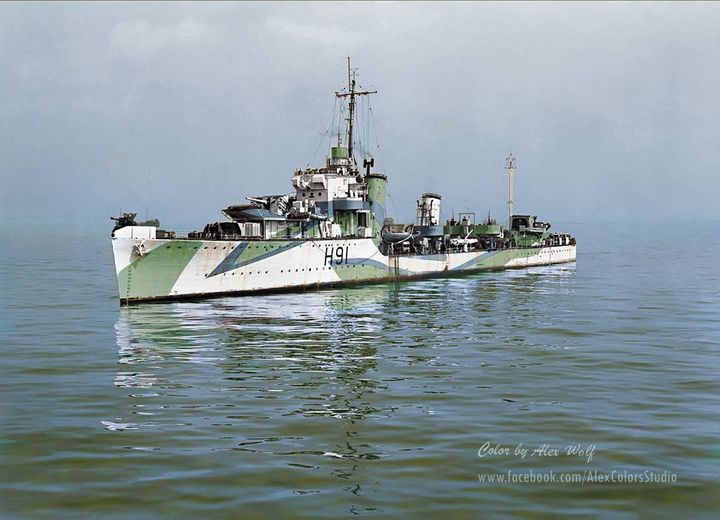
Colorized photo of HMS Bulldog, colorized by Alex Wolf (war in colors)
They appear in WW2 and were little changed in the 1930s, but accounting for the growing threat of aviation. Destroyers were already used to deal with submarines in WW1, equipped with depht charges and Y-guns. WW2 brought a whole new level in ASW warfare, but dedicated vessels were gradually preferred for escort duties rather than the versatile and costly destroyers.
Allied destroyers were engaged in the Arctic, Atlantic, Pacific and Indian Oceans, North and Mediterranean seas. In total, some 389 Australian, British and Canadian destroyers saw 150 losses or fatally damaged (total constructive loss or repairs deemed unpractical, not worth it). New weapons appeared, such as the hedgehog and the spigot and squid mortars, while detection also grew dramatically with the adoption of radar. Destroyers were used to escort convoys, a fleet or task force, perform aggressive moves, most often to protect, and raiding enemy merchant and naval ships. In Norway or Guadalcanal they also carried troops and were used in shore bombardment in many operations, like larger ships. For this reason the armament stayed as versatile as it was possible, with a main artillery able to deal with small ships, other destroyers, submarines or even light cruisers, torpedoes to sink all size of ships if they could close enough, AA to protect against air attack (although their small size limited the amount of AA that can be carried), and of course ASW warfare.
DDs has been jack-of all trades, notably ferrying troops back from the Dunkirk’s beaches in 1940, or carrying them in Norway, sometimes paying a heavy price (in Dunkirk in particular, which conducted Churchill to ask quick replacements and to the US, 50 older destroyers to be leased. One of the important role of destroyers has been escort; a role for which they were gradually replaced by cheaper and more suited vessels, frigates, corvettes and escort DDs.
British practice was generally to keep recent fleet destroyers for the Fleet and relegate older models to escort duties, but this proved unsatisfactory as the powerful powerplants still were gas-guzzlers limiting range for escort, and if armament address surface, air and submarine threats, this affected their stability and in the middle of the atlantic, the ASW threat was the only real one. In the end, convy duties urged more destroyers, that were already stretched between multiple theaters of operations. Smaller mass-built cheap vessels were irgently needed to free destroyers from this task.
At first the British adapted elderly British and later US destroyers (the four pipers) for ASW warfare, oftn removing part of the boilers to make room for more oil. The Hunt-class escort destroyers ordered before the war, in early 1939, were a feoresight of the Admiralty and proved only suited for the North Sea and Mediterranean due to their range. But soon, civilian yards will answer the call, delivering smaller ships for the North Atlantic: The Flower and Castle-class corvettes, River, Loch and Bay-class frigates, Black Swan-class sloops, in effect freed destroyers from escort duties by 1944.
Wartime actions showed some remarkable use of destroyers of their own as well:
The Battle of Cape Bon (Tunisia) in 1941: The British 4th Destroyer Flotilla (HMS Sikh, HMS Maori, HMS Legion and Dutch Isaac Sweers) intercepted, and defeated in battle the Italian cruisers Alberto di Giussano and Alberico da Barbiano. Both were -irony there- designed as destroyers hunters…
Capture of U-110 in 1941:
Operation Primrose was the detachment of a destroyer, HMS Bulldog, from convoy OB318 to capture U-110 and its top-secret Enigma cipher machine and associated documentation, a clear win for the allies.
St. Nazaire Raid, 1942 From the fifty lent destroyers from the US, HMS Campbeltown rose to fame. Known as the ex-USS Buchanan she was disguised as a German destroyer and loaded with commandos, plus explosives for the very dangerous but ultimately successful raid, ramming and destroying the local dry dock, the largest on this coast for German battleships such as the Bismarck and Tirpitz.
Battle of North Cape, 1943: This battle which saw the Scharnhorst sunk by a squadron composed of HMS Savage, Saumarez, Scorpion, HNoMS Stord, HMS Opportune, Virago, Musketeer and Matchless. It was like a wolf pack against a bear.
Battle of the Malacca Strait: IJN Haguro, a heavy cruiser, was intercepted engaged and sunk by the 26th Destroyer Flotilla (HMS Saumarez, Verulam, Venus and Virago) off Penang, on 16 May 1945.
WW1-era British destroyers
R class destroyers (1916-17)
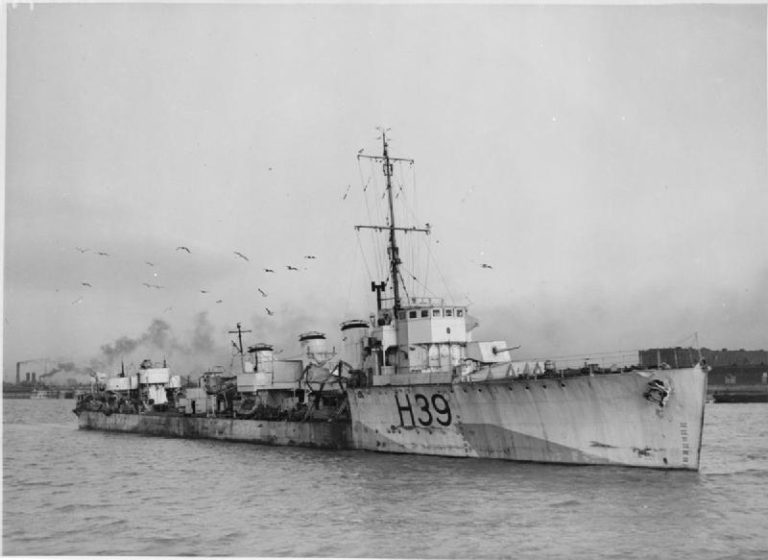
HMS Skate of R class in 1942
A few of this mass of R-class, improved S-class, were still active in 1939: HMS Skate participated in the Second World War, and HMS Radiant, sold in Siam in 1920 was active as Phra Ruang in 1942 during the French-Siamese war. Sea the WW1 DD section.
Shakespeare class leaders (1916-20)
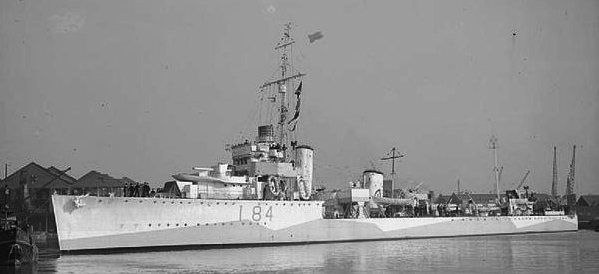
Thornycroft presented in admiralty competition in 1916 destroyers leaders who were to take the squadron of class V buildings and respond to the new German destroyers, which – according to intelligence service – had parts of 140 mm. Due to lack of time to develop new naval artillery pieces of equivalent caliber, a proven 4.7 inches (120 mm) field gun was adapted, relatively slow to reload to naval standards.
No less than five masked pieces constituted the endowment of this class, which became in fact the best armed of the moment. The Shakespeare were a new standard in the matter within the Royal Navy. Out of 7 ships will be ordered, two were cancelled in April 1919, and the Rooke and Keppel completed in the 1920s. The Shakespeare, the Spencer and the Wallace took part in the conflict.
They were followed by Scott class ships built at Cammell Laird’s. After the war, the Rooke will be renamed Broke while the Shakespeare and the Spencer will be put in reserve then sent for scrapping in 1936. In 1939, the survivors of this class were Wallace, Broke and Keppel, whose speed and weapons remained at Royal Navy standards.
Was later added the Huff-Duff and the sonar as standard, as well as ASW grenade launchers with a large supply, while removing their parts of 120 mm, two were retained. The Broke was one of the rare Allied ships destroyed during Operation Torch: She was sent to the bottom on November 8, 1942, by a coastal battery held by French faithful to Vichy, defending the port of Algiers. The Wallace will be rebuilt as an anti-aircraft destroyer and served as an Atlantic escort with the Spencer.

Auhor’s rendition of HMS Broke, of the Shakespeare class
Characteristics (Shakespeare, 1939):
-Displacement: 1500 t. standard -2 145 t. Full Load
-Dimensions: 101 m long, 9.6 m wide, 3.8 m draft (full load).
-Propulsion: 2 shaft Brown-Curtis turbines, 4 Yarrow boilers, 40,000 hp.
-Maximum speed 36 knots, RA 3000 nautical miles at 12 knots.
-Armour: 80 mm gun shields.
-Armament: 2 x 120 mm (2×1), 1 x 76 mm MK VI AA, 2 x 40 mm AA, 6 x 533 mm TTs (2×3), 1 Hedgehog, 8 mortars, 98 ASM grenades.
-Crew: 195
V/W class destroyers (1917-18)
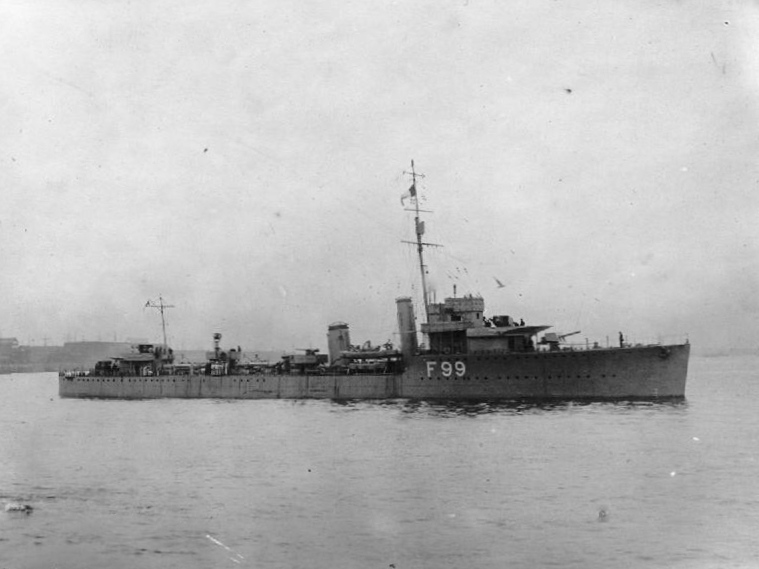
HMS Valentine, 1917 IWM
The “V” class of the great war formed the backbone of the light forces of the Royal Navy during the interwar period. These were 26 units organized in squadrons and led by the 5 Shakespeare-type leaders (see above). They proceeded from a new design resulting from false information coming from the British secret services that the Germans were secretly preparing a new standard of powerfully armed destroyers of more than 1200 tonnes.
The Vs were therefore dimensioned, their bridge reinforced to accommodate new banks of triple torpedo tubes. Bigger, taller, they held the sea better in bad weather and were better adapted to the Atlantic. The gun platforms were protected by steel steps, to break the blades, which was still new at the time. Their entire construction gave the impression of great robustness. They were de facto, much more massive than their German equivalents of the same era, more comfortable in the Baltic.
All took part in the great war: Built quickly, the last of the V series were accepted in service in June1918. A unit jumped on mines in August 1918, and one was also lost following a Soviet mine in 1919, and the third of a torpedo launched by a star also Soviet. Subsequently, four buildings were withdrawn from service in 1936 and cannibalized to keep the units in operation. 18 were in service in 1939, two of which were quickly paid to the Australian Navy (RAN).
A conversion into AA destroyer escort (AAE) was carried out on 7 units during 1940, when being equipped with new 102 mm DP turrets with rapid fire, four AA 20 mm Oerlikon guns under mask and an ASW complement of 45 vehicles for two lockers and two mortars. Their autonomy had also been increased, with almost 10 tonnes of additional fuel oil. Eight other British destroyers of this class were converted into long-range escorts (designed to escort convoys to the USA). For this, several boilers were sacrificed for the benefit of additional fuel oil reserves.
Their speed therefore fell to 25 knots, having only 15,000 hp “underfoot”. The equipment of this conversion specializing in ASM (LRE for Long Range Escort) fight included two to three pieces of 120 mm, 2 Bofors and 6 Oerlikon, but especially 110 grenades in traps, reserves, and 4 to 6 mortars.
Two others were converted to SRE (Short range escort): They kept their machinery and speed intact, but their armament was also changed. Some kept a bank of torpedo tubes. Others saw the addition later in the war of a Hedgehog (ASM rocket launcher) or sometimes a 47 mm Q-Gun with ultra-rapid fire, designed to fire at the kiosks of diving units.
The SREs carried out their standard electronic equipment including a Huff-Duff antenna (trigonometric tracking) and a sonar. Solid, these ships therefore waged their second war in thirty years. They were scrapped in 1946-47. The remaining units were untouched, except for the possibility of replacing one of their banks of torpedo tubes with a 47 mm rapid-fire cannon, the addition of 33 ASM grenades and two to four 20 mm AA guns.
Casualties in combat were relatively few: There was the Venetia, lost on a mine in Nov. 1940, the Vimiera which suffered the same fate in January 1942, and the Vortigern, torpedoed by a U-Boote in March 1942. In 1942, they all had a Huff-duff** antenna and an asdic-sonar.

HMS Viceroy in 1943, with her white livery for winter escorts of Murmansk convoys. Example of AAE conversion

HMS Viscount in August 1942, in “western approach” livery (North Atlantic convoys) Example of LRE conversion. (1/400)
Characteristics
-Displacement: 1500 t. standard -2 145 t. Full Load
-Dimensions: 101 m long, 9.6 m wide, 3.8 m draft (full load).
-Propulsion: 2 shaft Brown-Curtis turbines, 4 Yarrow boilers, 40,000 hp.
-Maximum speed 36 knots, RA 3000 nautical miles at 12 knots.
-Armor: 80 mm guns shields.
-Armament: 2 x 120 mm (2×1), 1 x 76 mm MK VI AA, 2 x 40 mm AA, 6 x 533 mm TTs (2×3), 1 Hedgehog, 8 mortars, 98 ASW grenades.
-Crew: 195
Scott class destroyers (1917-18)
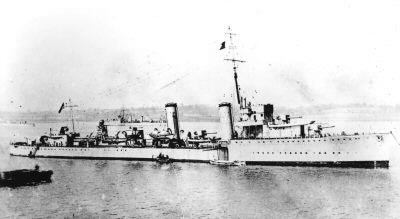
HMS Scott in 1917 – AWM
The Scott class was derived directly from the Shakespeare class. It was a series of eight squadron leaders launched in slight deferral. The Scott was indeed launched at the end of 1917 and the others during 1918, at Cammel Laird and Hawthorne Leslie. Only three took part in the last operations of the great war.
All but one (the Scott torpedoed on November 18, 1918) were operational in 1939, without modernization. The Scotts in their time confirmed the successful design of the Shakespeare. These buildings were in fact taken over to inspire the “standard” destroyers of the next generation.
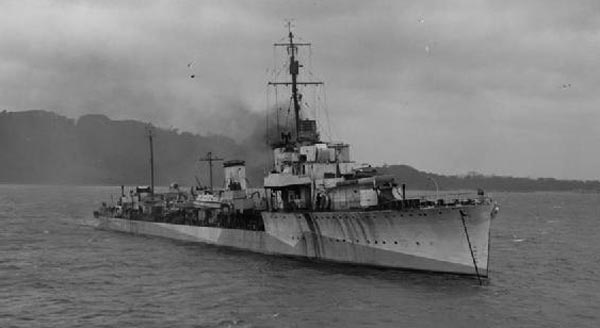
HMS Douglas in WW2
They also served as a basis for plans for destroyers sold for export. In 1942, the needs of the escort led to a drastic modernization. All thus lost their upper rear part (C) in favor of a 76 mm AA gun soon enough. It also involved replacing one of their banks of torpedo tubes with an artillery bench A, and at the front an ASW (P-Gun) 47 mm rapid-fire cannon, at the front for three units, another was equipped with a Hedgehog (Malcolm) with the addition of ASW grenades and two to four 20 mm AA guns.
They also all had a Huff-duff** antenna and an asdic-sonar. The Stuart was sent to serve with the RAN. They had a very active career and were broken up in 1947.


HMS Campbell, light blue livery 1939

HMS Montrose in 1943, Murmansk convoys
Characteristics
-Displacement: 1850 t. standard -2235 t. Full Load
-Dimensions: 101.3 m long, 9.7 m wide, 3.8 m draft (full load).
-Propulsion: 2 shafts Parsons turbines, 4 Yarrow boilers, 40,000 hp.
-Maximum speed 36 knots, RA 3000 nautical miles at 12 knots.
-Armor: Maximum masks of parts 80 mm.
-Armament: 3 x 120 mm (3×1), 1 x 76 mm MK VI AA, 2 x 40 mm AA, 6 x 533 mm TTs (2×3), 4 ASW mortars, 70 grenades.
-Crew: 164
W class destroyers (1918)
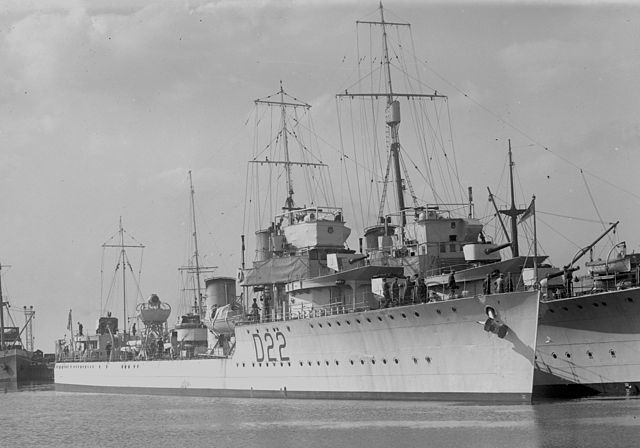
HMS Waterhen
This very important series was derived from the upsizing performed by wing leaders such as Shakespeare and Scott. Their tonnage was much higher, their armament reinforced, comprising four pieces of 102 mm QF under masks and six torpedo tubes in two axial benches. Their hull was reinforced for the harsh conditions of the North Atlantic.
A good part was operational at the end of the war, some participants in the blockade of Zeebrugge and Ostend. The hms Warwick will be seriously damaged there, but later towed by the hms Velox and repaired, it will resume service. The Waterhen and Voyager will be sent to the RAN (Royal Australian Navy) in 1933, the Walrus hit a reef and sank in 1938, while eighteen others were in service with equipment almost unchanged since their commissioning.
The imperatives of the escort missions quickly imposed their reconversion: 5 units were taken in hand for reconversion in SRE (Short Range Escort) 5 in AAE (Anti-aircraft escorts) and two in SRE (Short Range) with in particular a double Y-Gune to 76 mm rapid fire and 20 ASM grenades.
The others received an AA complement of 20 mm Oerlikon pieces and two 40 mm bofors, more in some cases a Y-Gun piece and 28 to 34 ASM grenades as well as mortars, all at the stern. From 1942, all received standard Huff-Duff and a recent asdic-sonar. 7 of them were sunk, including 6 in Europe by U-boats and Stukas, and one, hms Waterhen, by Japanese aviation in the Far East. The survivors were placed in reserve in 1945-46 and BU soon after.

HMS Walpole in gray “western approach” livery, Atlantic, 1942. Note the Y-Gun instead of the bank of torpedo tubes B

HMS Wolsey in 1939, with the standard livery of the time, medium gray hull and pale gray superstructures, and white bands of squadrons on the funnels.
Characteristics (Walpole, SRE 1942)
Displacement: 1665 t. standard 1710 t. Full Load
Dimensions: 95 m long, 9 m wide, 3.2 m draft (full load).
Propulsion: 2 propellers, 2 Parsons / Brown-Curtis turbines, 4 Yarrow boilers, 27,000 hp.
Performances: Maximum speed 34 knots, RA 2,500 nautical miles at 12 knots.
Armor: Maximum masks of parts 80 mm.
Armament: 4 x 102 mm (4×1), 2 x 76 mm MK VI AA ASM, 3 x 40 mm AA, 3 x 533 mm TT (1×3), 20 ASW grenades.
Crew: 134
British escort destroyers: The Hunt class
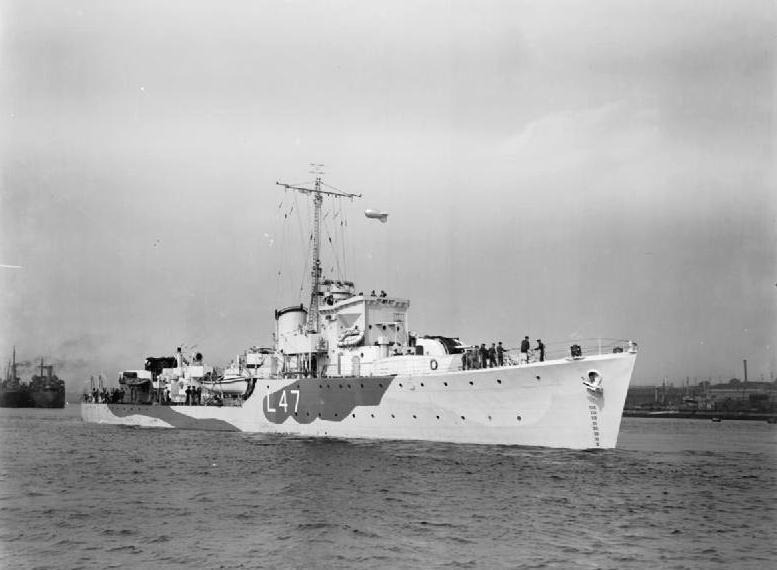
HMS Blean, Hunt type III destroyer.
No less than 86 escort destroyers were also built during the war, mirroring those in the US, but with much lower quantities, and they were started much earlier, in early 1939. They were the inspirators for US equivalents, but had loads of problems and were not very popular with their crews. The Hunt class nevertheless was complementary to the River, loch and Bay class ships or the smaller Flower and Castle class corvettes, in having more firepower, being also faster and more versatile. They were built in four series, the first launch from December 1939, the last (serie IV) in September 1942. By that time, the RN staff decided this type was superfluous and concentrated on cheaper escorts, while at the same time, the Royal Navy benefited from US transfers, 32 destroyer escorts of the GMT class and 46 of the TE class, called collectively the Captain class Frigates. They also received 21 Tacoma class Frigates, named the Colony class, delivered via lend-lease in 1944.
The names choices reflected their main purpose, to hunt any disruption to the convoys, whether u-Boats when surfaced or submerged, E-Boats or aircraft. All were named after British large hunting domains. The initial serie was plagued by stability problems, solved on the Type 2, better armed, and nearly 200 tonnes larger, while the type 3 (1941-42) was slightly lighter, and returned to the type 1 armament, but introduced a twin 21 inches torpedo tubes bank to better deal with E-Boats and any target of opportunity. The serie 4 was a one-off experiment by Thornycroft, larger with a longer forecastle, same armament as the type 2 and 3 but with a triple TT bank.
Hunt Serie I: These initial 23 ships has been planned as reduced version of destroyers, with 4-in guns armaments instead of 4.7 in. The initial plan called for six twin guns, but errors in calculations conducted to a flawed design, very unstable. Therefore the main armament was reduced t just two twin guns, of the Mark XVI HA dual purpose QF type. In addition they had a single quadruple pom-Pom 40 mm AA gun and 50 deep charges. They were built at Camell Laird, Yarrow, Vickers-Armstrong, John Brown, Swan Hunter, Scotts, White and Stephens. Just three were launched in 1939: Athertone, Eglington, and Hambledon, the rest in 1940. Construction was fast.
The Hunt Serie II Thirty-three of these were built with more beam for stability. Instead of stabilizers, three of these had extra oil tanks. Later in the war single bofors were added on some ships. DC provision rose to 60 and main armament now comprised three twin 6-in/45 Mark XVI HA and a quadruple pompom 40mm. Three were transferred to the free Polish Navy. There were a few losses during the war: HMS Dulverton in 13/11/1943, by an HS 293 flying bomb, Eridge in august 1942 by Italian MAS, Heythorpe in march 1943 by an U-Boat as well as Grove in june 1942 and Puckeridge in Sept. 1943, and Hurworth in october 1943 by mines, like Oakley and Southwold. Many sere sold after the war: Greece, Germany, Norway, Denmark and India.
The Hunt Serie III were not larger vessels, they had a lower draft, were displaced less. These tenwty-eight ships launched in 1941-42 were back to the Type I armament, just two 4-in twin mounts, one replaced by a twin TT banks to give them more versatility. AA was the same, but they carried ten DCs more (70). Six were lost in action, one by collision. After the war, they were sold mostly to Greece, Germany and Norway.
The Hunt Serie IV: They were the a clear step-up with 1700-1750 tonnes of displacement, 90.22 m (296 feets) overall, 10.16 m (34 ft 10 in) in width, 3.58 m in draft and were launched in June and September 1942 (HMS Brecon and Brissenden) with a forecastle extended to the rear ‘B’ DP mount. Basically they were an experiment, limited to just two ships but the Hunt serie was deiscontinued while at the same time, about 76 US-built destroyer escorts, named the “captain class”, were transferred ender lend-lease.
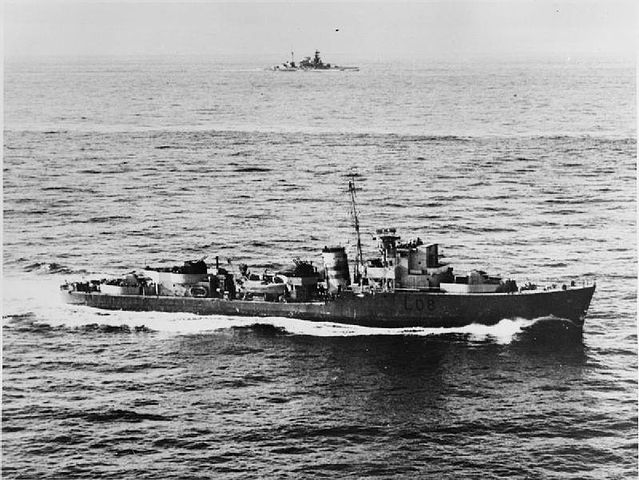
HMS Exmoor, a Type II hunt class (IWM)
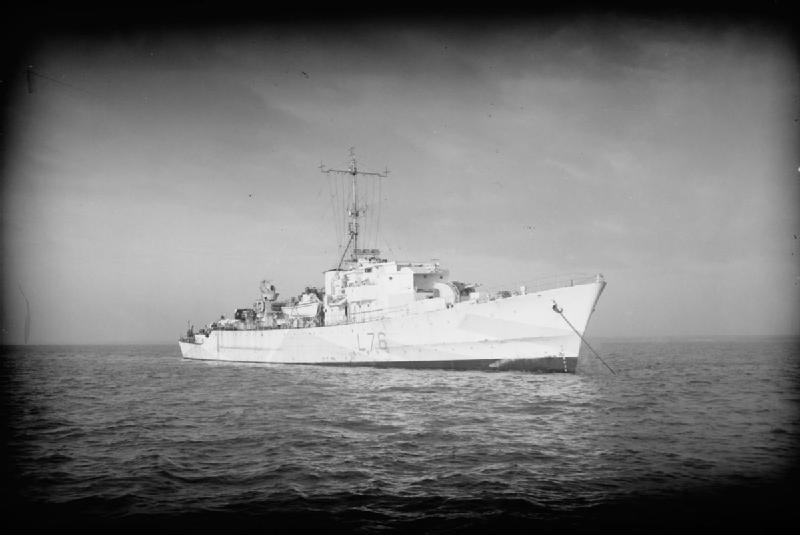
HMS Brecon, Type IV (AWM)
British lend-lease destroyer: 50 “four-pipers”
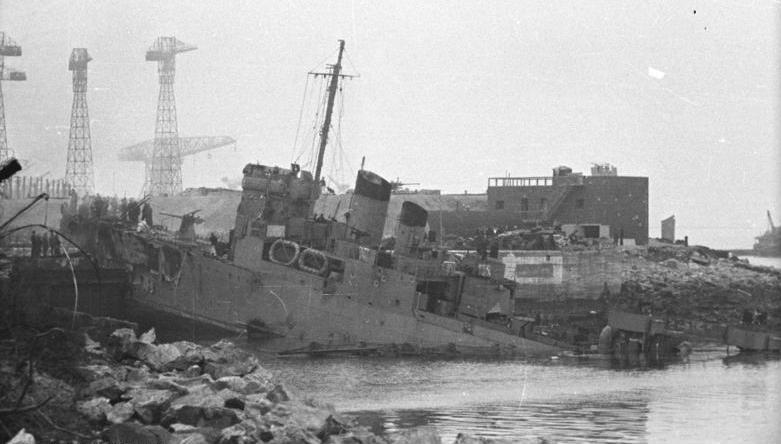
HMS Campbeltown at Saint Nazaire, probably the most famous of the British “four pipers” (bundesarchiv).
Also used for convoy escort at the beginning of the war were fifty ex-US destroyers of the old Caldwell class of 1917-1920, the famous “four-pipers”. After difficulties, President Roosevelt forced the Congress to agree to their transfer, despite arguments of an obvious breech of neutrality. Yhey were delivered in November 1940, at the insisting demand of Winston Churchill after the crippling losses of the 1940 campaigns of Norway, France (notably Dunkirk) and the Atlantic.
They were no more popular with British crews because of their very wet decks in the North Atlantic, but they were fast and rugged, and they were rearmed often for the purpose, with additional deep charges, sonar, radar, huff-duff over time, and TTs deposed as superfluitous.
Interwar British Destroyers
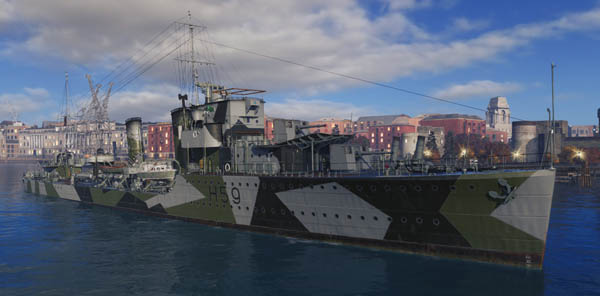
HMS Gallant of the G class () – wow rendition
Production of destroyers in UK started again in 1928.
Codrington et Greenville class destroyers leaders (1929-36)
The practice of leading squadrons of destroyers by vessels used for their coordination appeared in the era of torpedo boats at the end of the 19th century. The tradition then passed to the “destroyers”.
The admiralty simply put into practice the construction of ships specialized in this task. They were larger and better armed vessels than standard destroyers. The Scott had been during the great war of reference precursors.
But from 1924, the need for new leaders for classes A to F was felt and put him on hold isolated buildings in two successive classes: The three Codrington (launched in 1929, the first was to guide the “A “but also including the Exmouth and the Faulknor in 1934, to guide the “B” and “C”), and the Greenville, Hardy and Inglefield launched in 1936 for the”G”,”H” and “I”.
They remained close to the current design so far, with a fifth piece of artillery placed between the two fireplaces. The two classes were virtually identical, differing only in their tonnage (2,050 tonnes for the former versus 2009 tonnes CP for the following).
Losses were heavy in 1940: Codrington (Luftwaffe), Exmouth (U-Boote), Greenville (mine), and Hardy (duel with German destroyers), and finally Inglefield in February 1944 (Flying bomb Luftwaffe Henschel – actually an early anti-ship missile).

HMS Codrington in 1940
Characteristics
-Displacement: 1540 t. standard -2050 t. Full Load
-Dimensions: 104.50 m long, 10.3 m wide, 3.7 m draft (full load).
-Propulsion: 2 propellers, 2 Brown-Curtis turbines, 4 Admiralty boilers, 39,000 hp.
-Maximum speed 35 knots, RA 4000 nautical miles at 12 knots.
-Armor: 80 mm gun shields.
-Armament: 5 x 120 mm (5×1), 1 x 76 mm MK VI AA, 2 x 40 mm AA, 8 x 533 mm TTs (2×4), 2 ASM mortars, 2 racks, 120 grenades.
-Crew: 185
A/B class destroyers (1926-30)

HMS Achates 1942
It was not until 1924, two years after the signing of the Washington Treaty and the application of its ten-year moratorium, that the Admiralty considered building new destroyers. It inherited some 200 of them from the Great War, many of which had only entered service (notably the V-W classes) recently (1919-1920). However, the retirement of the oldest units, those of the 1914-1916 tranches, and that scheduled for the 1917-19 tranches in the long term, forced to plan a new design in 1923.
In 1925, the plans were ready, on specifications of speed and armament which placed the new series (taking up the beginning of the alphabet) in the line of the VW classes and always planned to function in squadrons led by more powerful destroyers leaders. This work resulted in a new successful standard, widely copied and produced for export.
The first series of 8 buildings from the 1926-28 tranche was followed by two units for the NCR. They carried as standard the new Mk IX gun of 4.7 inches (120 mm) quick-firing, protected by a steel shield of modest size, in four positions distributed between the front and the rear, two banks of tubes standard axial torpedo launchers (533 mm), a 76 mm AA “quick-firing” cannon, which was a relative failure in operation and replaced in 1941-42, and from one to two pieces of 40 mm anti-aircraft Bofors and deep-charges and rails which were added later, around 1936-39, as well as sonar and asdic.
The class B which followed for the 1928-30 tranche counted 9 other units, virtually identical although their hull had been slightly enlarged, their displacement going from 1350 to 1360 tonnes. Their AA armament varied during the war, but a bank of torpedo tubes was often sacrificed to place an additional AA artillery platform there. Some received from 4 to 6 Oerlikon pieces of 20 mm much more effective. Combat losses were heavy: 8 for the A and 5 for the B

HMS Achates in 1942
Characteristics
-Displacement: 1350 t. standard -1815 t. Full Load
-Dimensions: 98.45 m long, 9.7 m wide, 3.7 m draft (full load).
-Propulsion: 2 propellers, 2 Parsons or Brown-Curtis turbines, 4 Yarrow or Thornycroft boilers, 34,000 hp.
-Maximum speed 35.2 knots, RA 3000 nautical miles at 12 knots.
-Armor: Maximum masks of parts 80 mm.
-Armament: 4 pieces of 120 mm (4×1), 1 piece of 76 mm MK II AA QF (later 2 Bofors of 40 mm AA), 8 TLT 533 mm (2×4).
-Crew: 138
C/D class destroyers (1931-32)
Following very closely the successful series A and B in 1930, two new series of destroyers were launched. There were, however, only 4 Type C units and 8 Type D units, split into two squadrons led by Hms leaders Kempenfelt and Duncan.
However, the Cs were quickly sent to the NCR. They were notably larger in order to be able to accommodate more powerful machines and fuel oil reserves intended to improve their autonomy. In 1936, a new 40 mm Bofors AA quadruple carriage was tested on the HMS Crusader.
This arrangement caused instability problems, but was quickly adopted by larger buildings. From 1940, all these destroyers were re-equipped, often sacrificing one of their 120 mm pieces and a torpedo tube for reinforced ASM and AA armament. Their DCA varied, it was typically 2 pieces of 40 mm and 4 to 6 of 20 mm during the war, as well as a “hedgehog” (“hedgehog”), famous ASM rocket launcher mortar, and up to 125 grenades in rear racks and side mortars. All but 4 destroyers of these series were lost in action.
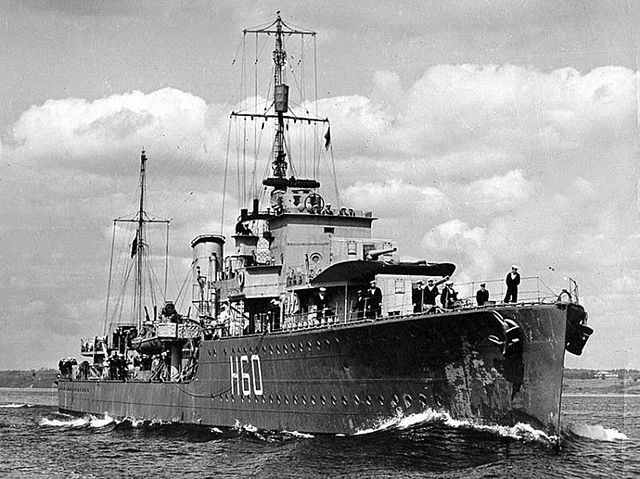
HMS Crusader in 1941, as HCMS Ottawa prior to 1942.
Characteristics
Displacement: 1400 t. standard -1940 t. Full Load
Dimensions: 100.30 m long, 10.1 m wide, 3.8 m draft (full load).
Propulsion: 2 propellers, 2 Parsons turbines, 4 Admiralty boilers, 36,000 hp. Maximum speed 36 knots, RA 5000 nautical miles at 12 knots.
Armor: Maximum masks of parts 80 mm.
Armament: 4 pieces of 120 mm (4×1), 1 piece of 76 mm MK II AA QF, 2 Bofors of 40 mm AA, 8 TLT 533 mm (2×4).
Crew: 145
E,F class destroyers (1933-34)
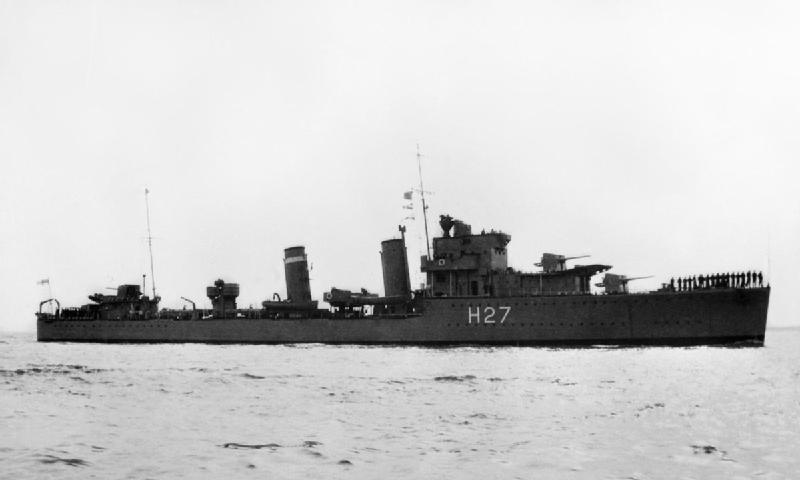
HMS Electra in 1939 (cc)
Two flotillas of 8 ships (9 according to other sources) were built in identical repetition of the previous ones, on a diagram which had been drawn in 1924. The improvements concerned the width of the hull, increased by a few inches, and the compartmentalization, more extensive than on the previous buildings. 9 were sunk during the conflict, some of them during the Battle of Java, an uneven defense against the Japanese fleet, while trying to protect HMS Exeter. Their AA and ASW equipment was continuously reinforced until 1944.
Characteristics (F class 1939)
Displacement: 1400 t. standard 205 t. Full Load
Dimensions: 100.3 m long, 10.1 m wide, 3.8 m draft (full load).
Propulsion: 2 shafts Parsons turbines, 4 Adm. boilers, 36,000 hp.
Performances: Maximum speed 36 knots, RA 5,000 nautical miles at 12 knots.
Armor: Maximum masks of parts 8 mm (0.3 in).
Armament: 4 x 12 mm (4×1), 1 x 76 mm MK II AA ASM, 2 x 40 mm AA, 8 x 533 mm TT (2×4)
Crew: 145
G, H, I class destroyers (1935-38)
This class of three identical building series spearheaded the British Empire’s destroyer force during the war. The G and H series consisted of twenty-four buildings. Series I eight buildings. The specifications included a “bunkerization” of the gangway, and the test was carried out on the “I” series of quintuple tube banks. For reasons of stability, we quickly returned in 1941 to the usual quadruple benches. Also in 1941, their DCA was reinforced (composed only of four Lewis machine guns), one 76 mm rapid-fire gun and four 20 mm Oerlikon.
As standard this armament passed to 6 pieces of 20 mm and the 76 was sometimes replaced by a 40 mm, while their ASM defense was pushed to have 125 grenades in boxes and mortars at the rear. For the rest the differences between the three classes were insignificant, relating to the compartmentalisation or details of width (increased on the “I”). All also received during the war, a Huff-Duff antenna and the sonar from 1940. The losses were massive in 1940 (7 units) and still 7 others on the remainder of the conflict is nearly 40% of the total.

hms Ithuriel

hms Highlander
Tribal class destroyers (1937-46)

ONI- Tribal class
Resulting from a failed design of a light cruiser (Design V, which was pursued by the Dido) which evolved into a squadron destroyer, the “Tribals” bearing the names of tribal peoples of the British Empire, were in their time considered among the most powerful destroyers in service in the world. The emphasis was deliberately placed on their speed, their “transatlantic” autonomy and above all their artillery, double that of a standard destroyer.
The preparatory work resulted in 1935 on a design of “pseudo turrets” housing 120 mm pieces in double solid hides, with anti-aircraft capability, in a classic configuration. The place given to the fittings and the DCA meant that only one bank of torpedo tubes was kept. The first series of 16 units spread out until 1939, followed in 1940-44 by three Australian units built at Cockatoo, then eight more for the NCR at Vickers and Halifax. The last two were accepted into service after the end of the war, one of them, the HMCS Haida, has been preserved and can be seen today in Hamilton, Ontario.
Their AA armament, consisting mainly of Vickers machine guns, was replaced by oerlikon guns, until 16 during the war, an arsenal which with the higher caliber “pom-poms” and their main turrets, gave them a considerable advantage as anti-aircraft escorts. Their career was very active and they showed all their versatility and left a memorable memory to their crews. The most famous was the hms Cossack which in 1939, took at night boarding “in the old way” the Altmark, the tanker supplying the privateer Graf Spee in a Norwegian fjord, to the indignation of this nation again. “neutral”. 12 units were lost between 1940 and 1943. The others remained in service until the 1960s and 1970s. Their unit cost was around £ 580,000.

HMCS Iroquois in 1944, used for convoy escort.
Characteristics (Tribal 1940)
Displacement: 1850 t. standard 2520 t. Full Load
Dimensions: 115 m long, 11.1 m wide, 2.7 m draft (full load).
Propulsion: 2 shafts Parsons turbines, 3 Adm. boilers, 44,000 hp.
Performances: Maximum speed 36 knots, RA 6,600 nautical miles at 15 knots.
Armor: Guns Masks 80 mm (3.1 in).
Armament: 8 x 120 mm (4×2) Mk.XII, 1×4 40 mm Bofors AA Mk.VIII, 2×8 13mm MGs, 4 x 533 mm TT (1×4)
Crew: 190-219
Characteristics (G class 1939)
Displacement: 1400 t. standard 2025 t. Full Load
Dimensions: 100.3 m long, 10.1 m wide, 3.8 m draft (full load).
Propulsion: 2 shafts Parsons turbines, 4 Adm. boilers, 36,000 hp.
Performances: Maximum speed 36 knots, RA 5,000 nautical miles at 12 knots.
Armor: Masks 80 mm (3.2 in).
Armament: 4 x 12 mm (4×1), 1 x 76 mm MK II AA ASM, 2 x 40 mm AA, 8 x 533 mm TT (2×4)
Crew: 145
J, K, N class destroyers (1938-41)
For once turning its back on twenty years of similar artillery configurations, the Admiralty decided to design a new class with a larger artillery. The only way to do this, while saving available space and stability, was through the use of double carriages, and a larger hull, 8 meters longer and one meter wider. This class echoed the great “Tribal”, a class of massive large squadron destroyers with eight pieces divided into eight turrets. Three classes of eight ships were launched, spread out between 1937 and 1941, the last “N” entering service during 1942.
Their good firepower was an asset in naval engagements in the North Sea and in particular in the Mediterranean, but also in the Pacific, in particular against the better armed Japanese destroyers. Their engine power was greater, as was their range, their speed remained constant to “admiralty” standards, 36 knots. The larger hull allowed the installation of quintuple torpedo launchers. Finally, the DCA was standardized into a single 40mm Bofors quadruple mount behind the chimney. During the war, they were added from 4 to 10 simple Oerlikon AA carriages and depth charges, up to 2 mortars and two racks for 45 grenades. They also had rangefinders of a new model, and a more powerful sonar. Thirteen units were lost during the conflict.

hms Kandahar
Characteristics (K class 1940)
Displacement: 1760 t. standard 2385 t. Full Load
Dimensions: 108.66 m long, 10.9 m wide, 3.8 m draft (full load).
Propulsion: 2 shafts Parsons turbines, 4 Adm. boilers, 40,000 hp.
Performances: Maximum speed 36 knots, RA 5,000 nautical miles at 12 knots.
Armor: Masks 8 mm (0.3 in).
Armament: 6 x 120 mm (3×2), 1×4 40 mm Bofors AA, 10 x 533 mm TT (2×5)
Crew: 183-200
L, M class destroyers (1940-42)
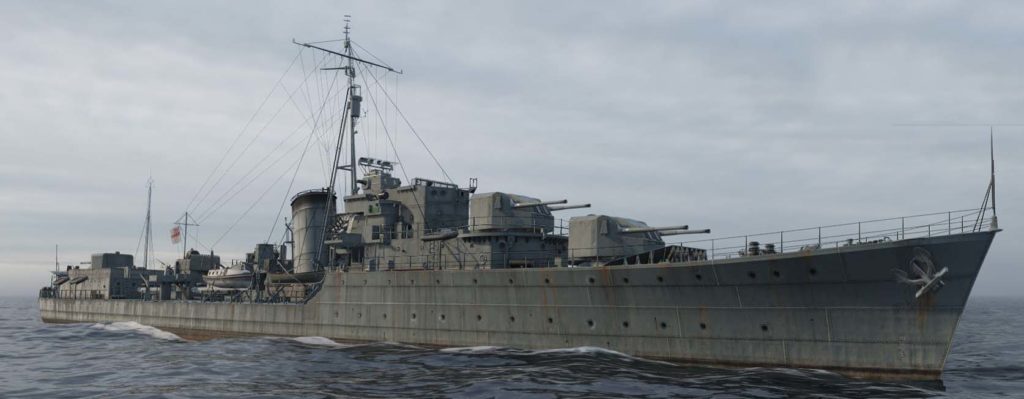
wow’s rendition of HMS Lightning
With the entry into the war of Great Britain, the need for a destroyer became even more pressing. The L and M classes (16 ships) were therefore urgently defined on the basis of the previous ones, but much larger, to the point of being equivalent to the “Tribal”, classified as super-destroyers. Their configuration was kept, but their main artillery was a new Mk.XII model of 50 calibers instead of 45, which gave them greater range. However these new carriages were difficult to develop, which gave rise for the first four of the “L” series to the unusual assembly of four double turrets with 106 mm AA vocation with rapid firing. It also came back to quadruple tube banks to improve their stability.
Another AA conversion was applied to some vessels that swapped their rear torpedo tube bank for a similar AA mount. The DCA was especially reinforced by the addition of 20 mm Oerlikon pieces, from 6 to 10 depending on the building. The last to enter service was HMS Mahratta (1943), transported for completion elsewhere when the Scott yards were shelled by the Luftwaffe. There were nearly 50% losses in combat, including the Orkan, under the flag of the Polish Navy. Four were sold to Turkey in 1959 and were in service until the 1980s.

HMS Legion in 1941, as an emergency anti-aircraft escort with four rapid-fire DP Mk XVI turrets.
Characteristics (L class 1940)
Displacement: 1920 t. standard 2660 t. Full Load
Dimensions: 110.40 m long, 11.3 m wide, 3 m draft (full load).
Propulsion: 2 shafts Parsons turbines, 4 Adm. boilers, 40,000 hp.
Performances: Maximum speed 36 knots, RA 5,500 nautical miles at 15 knots.
Armor: Masks 80 mm (3.1 in).
Armament: 6 x 120 mm (3×2) Mk.XI, 1x 76 mm Mk.V, 1×4 40 mm Bofors AA Mk.VIII, 8 x 533 mm TT (2×4)
Crew: 190
O, P, Q, R class destroyers (1941-42)
Obdurate, Obedient, Offa, Onslaught, Onslow, Opportune, Oribi, Orwell, Pakenham, Paladin, Panther, Partridge, Pathfinder, Penn, Petard, Porcupine, Quadrant, Quail, Quality, Queensborough, Quentin, Quiberon, Quickmatch, Quilliam, Racehorse, Raider, Rapid, Redoubt, Relentless, Rocket, Roebuck, Rotherham.
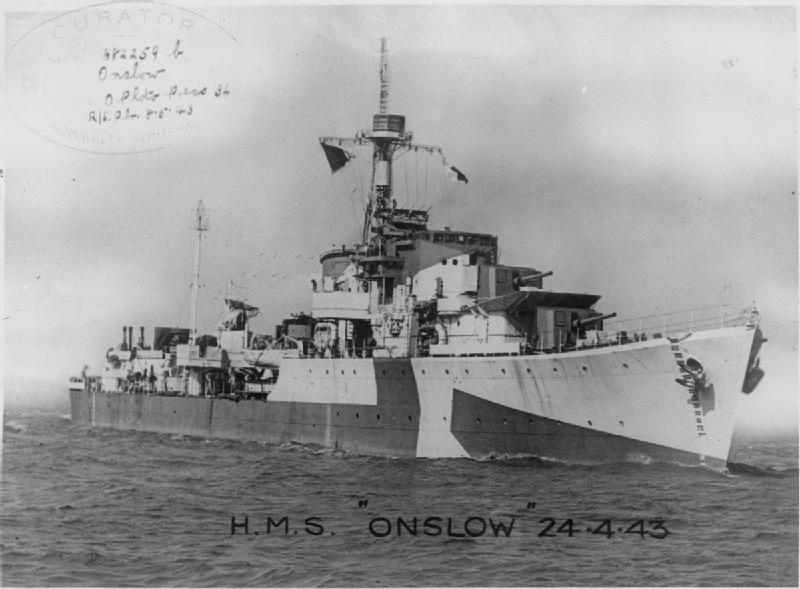
HMS Onlsow 1943
The O and P are aofter separated from the Q and R as they diverged in dimensions. However the were very similar in general concept and armament and a radical departure over previous L-M, which were judged a too costly endeavour. They came back to the traditional prewar design, with four individual 4.7 in guns. The following S, T, U, V, W, Z and “Ca” class as well as the Ch, Co, Cr, all followed the same path, with larger dimensions, better range and overall better AA.
They were considered by the admiralty as a smaller utility design with the “J” class machinery and reduced J class hull. HMS Onslow and Packenham were fitted as flotilla leaders, and Obedient, Obdurate, Opportune and Orwell were intended as minelayers with only three guns and 60 mines, while Offa, Onslaught Onslow and Oribi had new 40° elevation mountings for the 4.7 in/45 guns. Some had one TT banks replaced by an aft 4-in Mk.V AA which became mandatory on the late O class and the P class, and became later a standard. HMS Petard was rearmed in 1945 with tw twin 4-in Mk XVI HA and eight 20 mm AA. Many of these destroyers received additional 20 mm AA guns, four in general.
They also carried 70 deep charges in poop racks and side throwers. They were also fitted with radar, huff-duff and when modernized, had a derrick mast instead of their tripod. They were laid down from 1939, launched 1941-42, and completed before the end of 1942 for the last. War lessons has been learnt in between. HMS Packenham was torpedoed by Italian MAS and scuttled, Partridge and Porcupine sunk by U-Boats, Panther Pathfinder sunk by planes. Three were transferred to Pakistan after the war, and HMS Oribi became the Turkish Gayret.

General overview of the OPQR class in 1942.
The following Q-R classes were similar apart larger dimensions (see below), and they had a transom stern. The “j” class machinery was improved and they carried more oil fuel for increased radius. The armament was the same, but more modern Mark IX for the main guns, but they kept their two TT banks (no alt. AA gun). Their light AA was reinforced with 2-3 single Bofors and 4-8 20 mm oerlikon. They also carrier more deep charges, 130. They were noted for their excellent stability with a GM at 3.16 feets at 2412 tonnes. Launched all in 1942, they were completed until 1943. Five were transferred to Australia, Quilliam and Rotherham were fitted as leaders. Quentin was sunk by aerial torpedoes, Quail hit a mine in 1943. One after the war was transferred to the Dutch navy (Banckert), and three to India.
Characteristics (O class 1942)
Displacement: 1540-1550 t. standard 2220-2270 t. later 2430-2480 t. Full Load
Dimensions: 100.2-103.48 m long, 10.67-10.87 m wide, 4.11-4.2-4.3 m draft (full load).
Propulsion: 2 shafts Parsons turbines, 2 Adm. 2-drum boilers, 40,000 hp.
Performances: Maximum speed 37 knots, oil 472-588 tonnes RA 6,600 nautical miles at 15 knots.
Armor: Guns Masks 80 mm (3.1 in).
Armament: 4 x 120 mm (4×1) Mk.V/IX HA, 1×4 40 mm Bofors AA Mk.VIII, 8 x 533 mm TT (2×4)
Crew: 175-225
S, T, U, V, W class destroyers (1942-43)
Saumarez, Savage, Scorpion, Scourge, Serapis, Shark, Success, Swift, Troubridge, Teazer, Tenacious, Termagant, Terpsichore, Tumult, Tuscan, Tyrian, Grenville, Ulster, Ulysses, Undaunted, Undine, Urania, Urchin, Ursa, Hardy, Valentine, Venus, Verulam, Vigilant, virago, Viwen, Volage, Kempenfelt, Wager, Wakeful, Wessex, Whelp, Whirlwind, Wizard, wrangler.
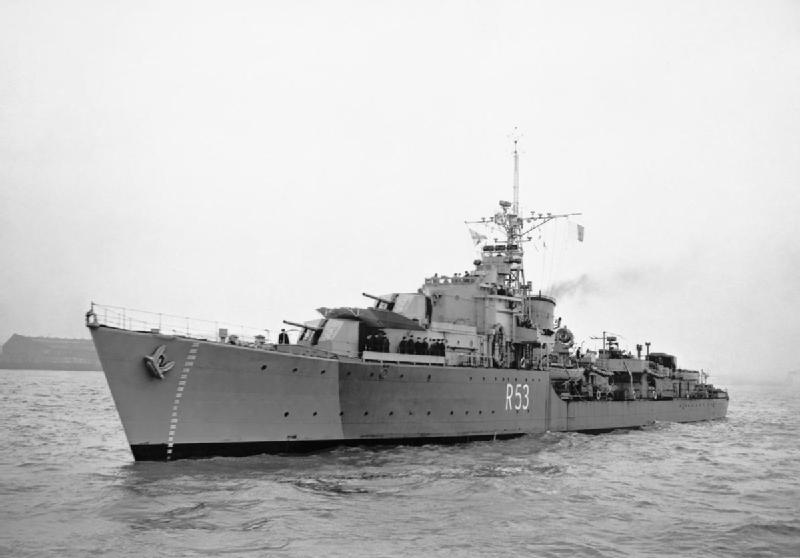
HMS Undaunted 1944 (IMW)
Similar to the previous class with with for some the Tribal class clipper bow, making them longer (103 to 110 m). This helped them to be less wet forward. All the new 4.7 in mark IX had high angle mountings with 55° elevation, more ammunitions, and a triaxial twin Bofors instead of the traditional quad. HMS Savage tested a forward pair of single mark III 4.5 in/45 with 80° mounting, faster-firing. Four ships retained their quad bofors, and two had only 20 mm Oerlikon guns. On this matter, the ships were added up to 5 single extra Bofors and up to twelve 20 mm Oerlikon guns and 130 deep charges. The last were completed in 1944. Saumarez, troubridge, Grenville, Hardy, Kempenfelt were fitted as flotilla leaders, they even had names of former ones. HMS Shark was transferred to Norway and sunk by an E-boat, hardy by an U-Boat, Swift hit a mine. Valentine and Vixen joined the RCAN, three were transferred to the Dutch navy, one went to Norway, two to Yugoslavia, Three to South Africa after the war.

HMS Terpsichore in 1945 (T class)

General overview of the S class in 1944.
Characteristics (S-V class 1942)
Displacement: 1710-1730 t(1780-1810). standard 2505-2545 t. Full Load
Dimensions: 110.56 m long, 10.87 m wide, 4.32-37 m draft (full load).
Propulsion: 2 shafts Parsons turbines, 2 Adm. 3-drum boilers, 40,000 hp.
Performances: Maximum speed 36.75 knots, oil 588 tonnes RA 6,600 nautical miles at 15 knots.
Armor: Guns Masks 80 mm (3.1 in).
Armament: 4 x 120 mm (4×1) Mk.IX HA, 1×2 40 mm Bofors AA Mk.VIII, 8 x 533 mm TT (2×4)
Crew: 180-225
Z, Ca class destroyers (1943-44)
Myngs, Zambesi, Zealous, Zebra, Zenith, Zephyr, Zest, Zodiac, Cavendish, Caesar, Cambrian, Caprice, Carron, Carysford, cassandra, Cavalier.
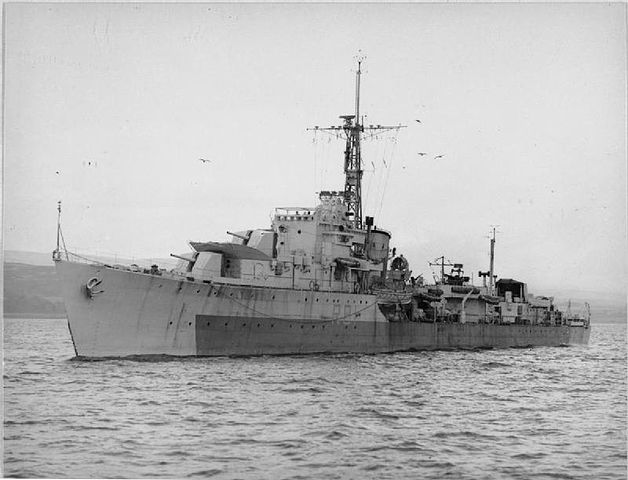
HMS Zebra
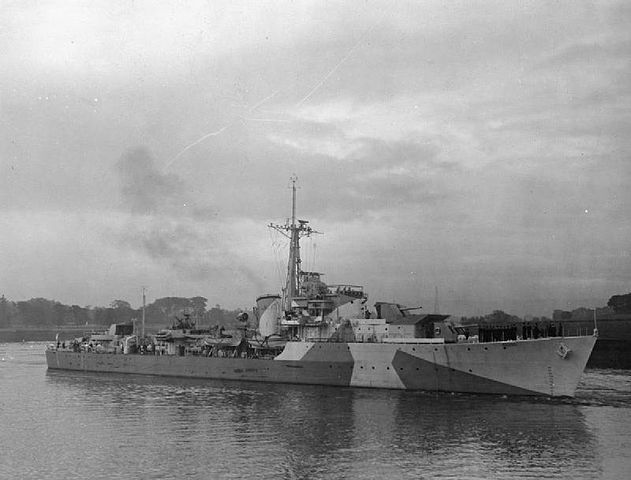
HMS Caesar 1944 – IWM
They were virtually repeats of the previous class, but wit improved fire contrl and the new 4.5 in/45 QF mark IV and 55° mounting. They also had a twin triaxial Bofors mount and in addition ofter four single bofors, up to eight 20 mm guns, 130 deep charges, but it varied between ships. The last were completed in early 1945. HMS Myngs and Cavendish were fitted as leaders. No wartme loss, after the war, two became Egyptian, and two Israeli.

General overview of the S class in 1944.
Characteristics (S-V class 1942)
Displacement: 1710-1730 t. standard 2510-2560 t. Full Load
Dimensions: 110.56 m long, 10.87 m wide, 4.34-42 m draft (full load).
Propulsion: 2 shafts Parsons turbines, 2 Adm. 3-drum boilers, 40,000 hp.
Performances: Maximum speed 36.75 knots, oil 588 tonnes RA 6,600 nautical miles at 15 knots.
Armor: Guns Masks 80 mm (3.1 in).
Armament: 4 x 113 mm (4×1) Mk.IX HA, 1×2 40 mm Bofors AA Mk.VIII, 8 x 533 mm TT (2×4)
Crew: 186-222
Ch/Co/Cr class destroyers (1944-45)
Chaplet, Charity, Checkers, Cheviot, Chevron, Checker, Chivalrous, Childers, Cockade, Comus, Concord, Comet, Constance, Contest, Cossack, Creole, Crescent, Crispin, Cormwell, Crown, Croziers, Cusader, Crystal.
Similar to the previous class but with one less TT banks in order to accomodate the new 4in/RPC gear. The twin Bofors in triaxials were replaced on seven ships by simpler biaxial. Light AA varied, in general two single 40 mm Bofors and two 20 mm or six. Deep charges carried varied from 48 to 70 or 108. The first ships were laid down in 1943, the last were completed after the war in 1946. HMS Contest became the first destroyer with all-welded hull in the Royal Navy. Four after the war were sold to Pakistan, and four to Norway.

General overview of the S class in 1944.
Characteristics (Ch/Co/Cr class 1944)
Dimensions: same but 4.39 m draft (full load).
Battle class destroyers (1943-46)
Armada, barfleur, Cadiz, Camperdown, Finisterr, Gabard, Greavelines, hogues, Lagos, St James, st Kitts, Saitnes, Sluys, Solebay, Trafalgar, Vigo. IInd group: Agincourt, Aisne, Alamein, Barrosa, Corruna, Dunkirk, Matapan, Jutland, Matapan
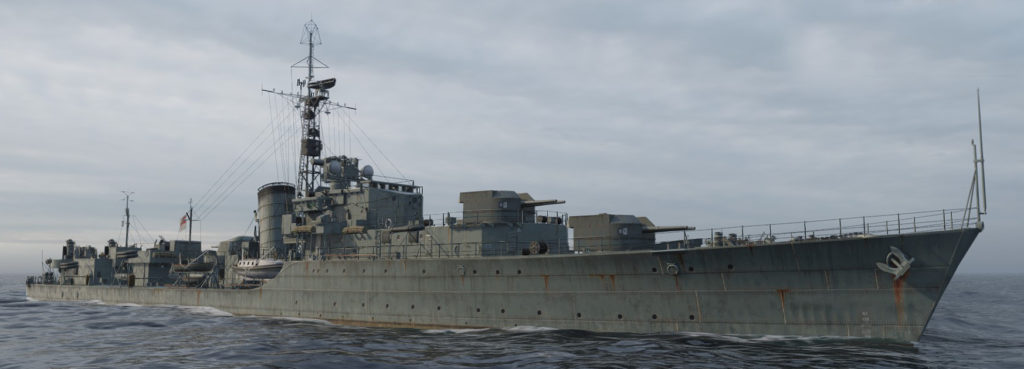
wow’s rendition of HMS Jutland
The Battle class, released on two groups were seen and larger version of previous destroyers intended for the far east and the pacific. They were larger and had longer range while their armament was more dual purpose, and concentrated at the front in twin turrets, allowing the rear to be used by a more powerful AA. At full load they reached 3300 to 3420 tonnes, compared to the Tribal’s 2700 tonnes. They were easily the most powerful British destroyers ever built and made a long career postwar, BU on the 1960s and 1970s. Two were sold however to Pakistan and one to Iran, the latter heavily rebuilt and modernized. HMS Armada, Barfleur, St James, Saintes, Solebay, Trafalgar were fitted as leaders and the bows were inspired by the Tribals, they also had a transom stern.
The dual purpose 4.5 in mark III had a 80° elevation. two ships tested Denny stabilizers. They all had derrick masts and radars. Five ships had an additional 4-in guns to fire flares. The great difference with previous ships was their two quadruple Bofors AA at the rear, both elevated on the quarterdeck. On some, the Bofors were in twin STAAG mountings instead and AA was supplemented by 6 more Bofors and pompoms for others, Armada having two 20 mm Oerlikon. They also carried 60 deep charges. In 1947, the main guns were upgraded to the Mark V pattern, much faster and with 90° elevation.

General overview of the Battle class in 1945.

Battle class 2nd group, conway’s profile
Characteristics (Battle class 1944)
Displacement: 2315-2325/2380-2400 t. standard 3290-3300/3400-3420 t. Full Load
Dimensions: 108.20 m long, 12.27-34 m wide, 4.62-37m draft (full load).
Propulsion: 2 shafts Parsons turbines, 2 Adm. 3-drum boilers, 50,000 hp.
Performances: Maximum speed 35.75 knots, oil 727 tonnes RA 8,000 nautical miles at 15 knots.
Armament: 4 x 113 mm (4×2) DP Mk.III, 4×4 40 mm Bofors AA Mk.VIII, 8 x 533 mm TT (2×4)
Crew: 247-308
Coldwar British destroyer completions and conversions:
Weapon class destroyers (1945-46)
Battleaxe, Broadsword, Crossbow, Scorpion
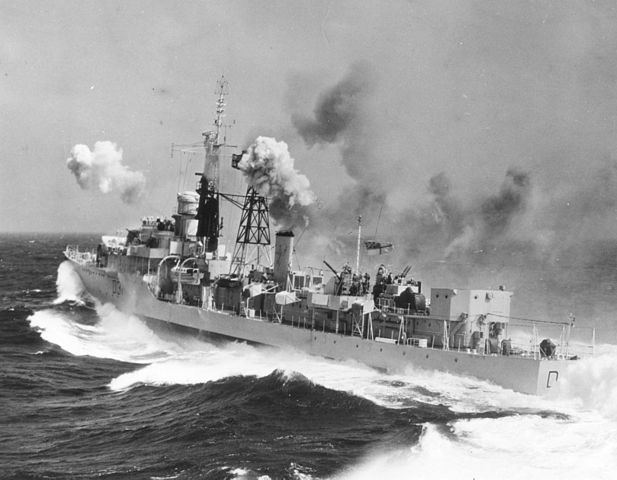
HMS Broasword in heavy weather (MoD)
These were the smaller counterpart to the Battle class and first new destroyer designs since the WW2 War Emergency Programme, with 20 ships planned, 13 were laid down but only 7 were launched, and 4 completed. Two were ordered as part of the planned C class, 15th Emergency flotilla in 1944, later changed to the new design. The hull length was about the same as the War Emergency Programme design, beam and draught increased to avoid being overweight and keep som room for more modernization. Two full sets of torpedo tubes were carried. They also carried a “unit” system of side-by-side boiler and engine rooms with alternate port/starboard arrangement as in USN DDs. For AA, three twin 4-in Mark XIV mounts were carried which were remotely controlled by a Type 275 Radar and Mark VI(M) director. This was sci-fi extravaganza in 1945.

Profile of the Weapons class, as converted in radar picket postwar.
Characteristics (Weapon class 1946)
Displacement: 1965-1980 t. standard 2825 t. Full Load
Dimensions: 111.25 m long, 11.58 m wide, 4.47 m draft (full load).
Propulsion: 2 shafts Parsons turbines, 2 Foster Wheeler boilers, 40,000 hp.
Performances: Maximum speed 34 knots, oil 620 tonnes RA 6,000 nautical miles at 15 knots.
Armament: 6 x 102 mm (3×2) Mk.XVI HA, 2×2 40 mm Bofors AA Mk.VIII, 10 x 533 mm TT (2×5)
Crew: 255-286
‘G’ class destroyers (1946-48)
Gael, Gallant, Gauntlet, Glowworm, Gift, Guernsey, Grafton, Greyhound.

prospective Profile of the G class.
This little-known class planned in 1945 was a follow-up of the Weapon class, but with 18 more inches of beam and heavier main armament of two twin 4.5 in guns Mark V. for and aft in enclosed semi-automated turrets. Bofors were distributed in two twin and two single mounts like previous ships. They were all cancelled while already ordered at Yarrow, Thornicroft, Denny and White NyDs. Therefore they were never built.
Characteristics (Weapon class 1946)
Displacement: 1965-1980 t. standard 2825 t. Full Load
Dimensions: 111.25 m long, 11.58 m wide, 4.47 m draft (full load).
Propulsion: 2 shafts Parsons turbines, 2 Foster Wheeler boilers, 40,000 hp.
Performances: Maximum speed 34 knots, oil 620 tonnes RA 6,000 nautical miles at 15 knots.
Armament: 6 x 102 mm (3×2) Mk.XVI HA, 2×2 40 mm Bofors AA Mk.VIII, 10 x 533 mm TT (2×5)
Crew: 255-286
Daring class destroyers (1949-52)
Dainty, Daring, Decoy, Defender, Delight, Diana, Diamond, Duchess
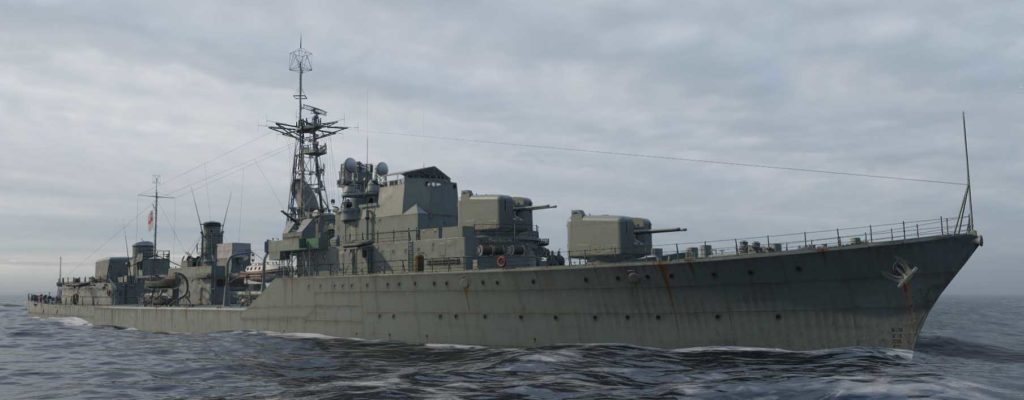
wow’s rendition of the Daring class
These were the Last pure fleet destroyers of Royal Navy, with many characteristics improved, notably the 1.0 – 1.1m metacentric height for an excellent stability and 450-500m tactical diameter for agility or a machinery using steam with highest standards of efficience. 16 ordered, but most cancelled, but the ships seen above. The last were laid down in 1947-48 but the first in September 1945 so they only registered here as they were planned, designed and ordered during WW2 in effect. After their modernization they were completed in 1952-54 and served until the 1980s for some.
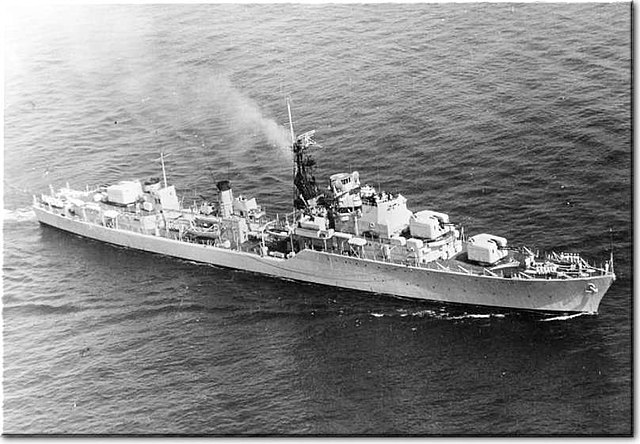
Photo of HMS Daring in the 1960s
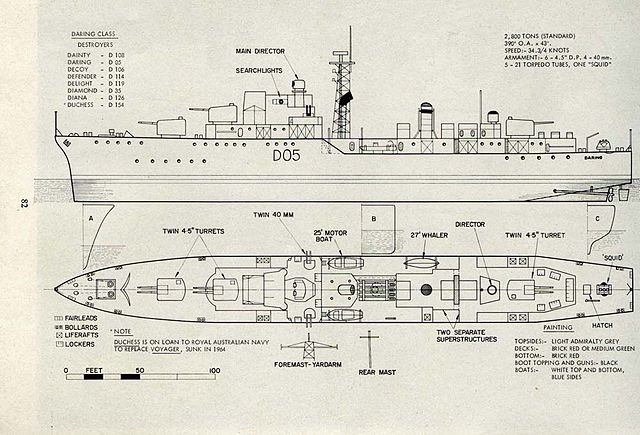
Original drawing of the Daring class.
Characteristics (Daring class 1953)
Displacement: 2830 t. standard 3580 t. Full Load
Dimensions: 118.8 m long, 13.10 m wide, 4.10 m draft (full load).
Propulsion: 2 shafts DR geared turbines, 2 Foster Wheeler/B&B boilers, 54,000 hp.
Performances: Maximum speed 34.75 knots, oil 590 tonnes RA 6,000 nautical miles at 15 knots.
Armament: 6 x 102 mm (3×2) 4.5 in Mk.XVI HA, 3×2 40 mm Bofors AA Mk.V, 2x 40mm/60 MkIX, 1 Squid ASWRL
Sensors: Radar 903, 262, 293, sonar 170, 174-177
Crew: 297-330

wow’s rendition of the Daring class
Coldwar conversions into ASW frigates: This would be the object of a whole chapter, in the Coldwar dedicated section.
-‘Rapid’ class Frigates, converted from 1941-42 also called Type 15 full conversion: 23 ships.
-‘Tenacious’ class Frigates, 1940-41 destroyers, type 16 limited conversion: 10 ships.
Coldwar conversion as radar pickets: Same here, but just let’s cite:
-The ‘Weapons’ class radar pickets (Battleaxe, Broadsword, Crossbow, Scorpion)
-The ‘Battle’ class radar pickets (Agincourt, Aisne, Barrosa, Corunna)
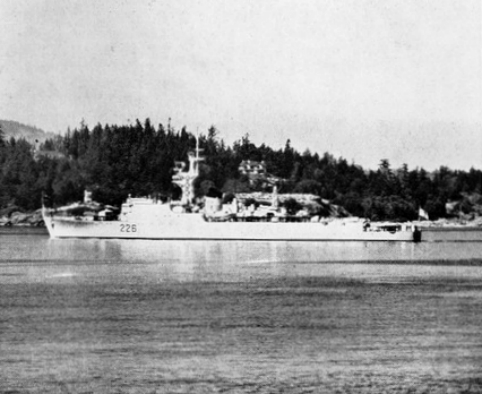
HCMS Crescent after ASW Frigate conversion in 1958
Read More/Src
J class DDs complete overview by ww2ships.com (pdf)
http://www.navypedia.org/ships/uk/uk_torpedoships.htm
http://www.navweaps.com/Weapons/WAMBR_ASW.php
//en.wikipedia.org/wiki/Admiralty_type_flotilla_leader
//en.wikipedia.org/wiki/A-_and_B-class_destroyer
//en.wikipedia.org/wiki/British_World_War_II_destroyers
Books:
J. Gardiner, Conway’s all the world’s fighting ships 1906-1921 & 1922-1947
Ships of the Royal Navy by J. J. Colledge
Ships of the Royal Navy: The Complete Record of All Fighting Ships of the Royal Navy from the 15th Century to the Present, by Ben Warlow and J. J. Colledge
Naval Weapons of World War One by Norman Friedman
British & Empire Warships of the Second World War by H. T Lenton
British Destroyers & Frigates by Norman Friedman
The Battle for Norway: April-June 1940 by Geirr H. Haarr
British Destroyers 1939-45: Pre-war classes by Angus Konstam
Jane’s Fighting Ships of World War 1 by John Moore
British Destroyers 1870-1935 Norman Friedman
Destroyers of World War Two by Michael J. Whitley
Models:
TAMIYA Ship Kit 1:700 31904 British Destroyer O Class
TAMIYA 1/700 31910 AUSTRALIAN DESTROYER VAMPIRE
TAMIYA 1/700 31909 BRITISH E CLASS DESTROYER
Airfix 1/600 05204 DD pack HMS Cossack, HMS Campbeltown, HMS Hotspur
Revell British HMS Campbeltown 1/240
IBG MODELS 1/700 70003 ORP KRAKOWIAK 1944 HUNT II CLASS DESTROYER ESCORT
Various models by Trumpeter

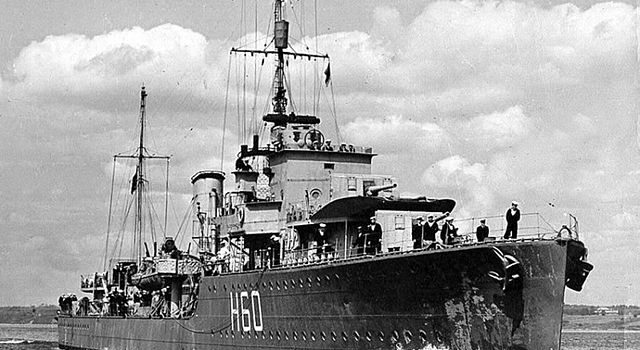

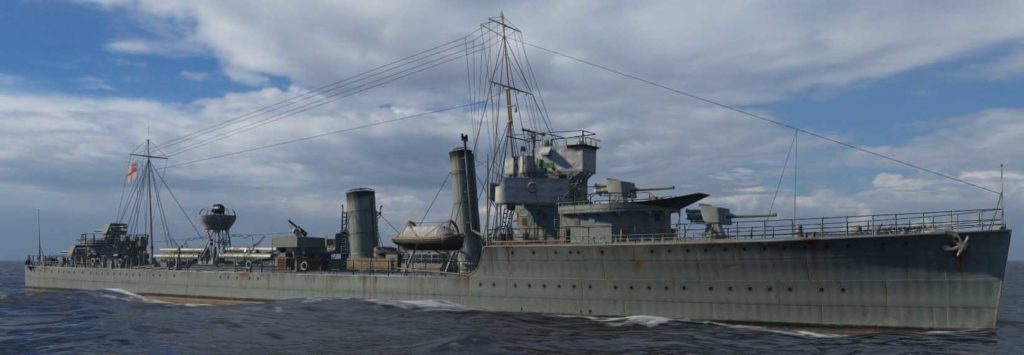
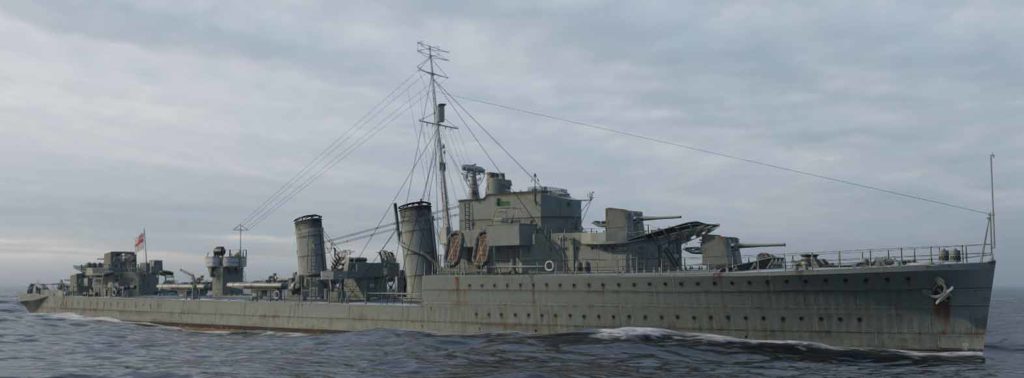
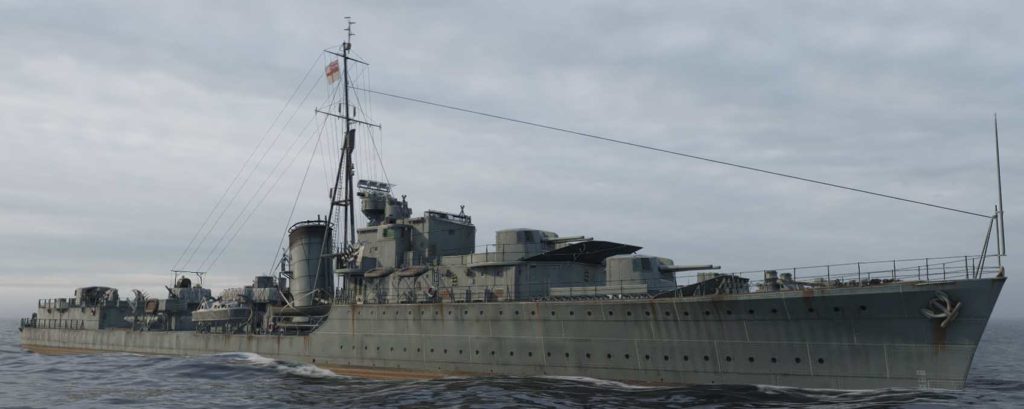
 Latest Facebook Entry -
Latest Facebook Entry -  X(Tweeter) Naval Encyclopedia's deck archive
X(Tweeter) Naval Encyclopedia's deck archive Instagram (@navalencyc)
Instagram (@navalencyc)





 French Navy
French Navy Royal Navy
Royal Navy Russian Navy
Russian Navy Armada Espanola
Armada Espanola Austrian Navy
Austrian Navy K.u.K. Kriegsmarine
K.u.K. Kriegsmarine Dansk Marine
Dansk Marine Nautiko Hellenon
Nautiko Hellenon Koninklije Marine 1870
Koninklije Marine 1870 Marinha do Brasil
Marinha do Brasil Osmanlı Donanması
Osmanlı Donanması Marina Do Peru
Marina Do Peru Marinha do Portugal
Marinha do Portugal Regia Marina 1870
Regia Marina 1870 Nihhon Kaigun 1870
Nihhon Kaigun 1870 Preußische Marine 1870
Preußische Marine 1870 Russkiy Flot 1870
Russkiy Flot 1870 Svenska marinen
Svenska marinen Søværnet
Søværnet Union Navy
Union Navy Confederate Navy
Confederate Navy Armada de Argentina
Armada de Argentina Imperial Chinese Navy
Imperial Chinese Navy Marinha do Portugal
Marinha do Portugal Mexico
Mexico Kaiserliche Marine
Kaiserliche Marine 1898 US Navy
1898 US Navy Sovietskiy Flot
Sovietskiy Flot Royal Canadian Navy
Royal Canadian Navy Royal Australian Navy
Royal Australian Navy RNZN Fleet
RNZN Fleet Chinese Navy 1937
Chinese Navy 1937 Kriegsmarine
Kriegsmarine Chilean Navy
Chilean Navy Danish Navy
Danish Navy Finnish Navy
Finnish Navy Hellenic Navy
Hellenic Navy Polish Navy
Polish Navy Romanian Navy
Romanian Navy Turkish Navy
Turkish Navy Royal Yugoslav Navy
Royal Yugoslav Navy Royal Thai Navy
Royal Thai Navy Minor Navies
Minor Navies Albania
Albania Austria
Austria Belgium
Belgium Columbia
Columbia Costa Rica
Costa Rica Cuba
Cuba Czechoslovakia
Czechoslovakia Dominican Republic
Dominican Republic Haiti
Haiti Hungary
Hungary Honduras
Honduras Estonia
Estonia Iceland
Iceland Eire
Eire Equador
Equador Iran
Iran Iraq
Iraq Latvia
Latvia Liberia
Liberia Lithuania
Lithuania Mandchukuo
Mandchukuo Morocco
Morocco Nicaragua
Nicaragua Persia
Persia San Salvador
San Salvador Sarawak
Sarawak Uruguay
Uruguay Venezuela
Venezuela Zanzibar
Zanzibar Warsaw Pact Navies
Warsaw Pact Navies Bulgaria
Bulgaria Hungary
Hungary

 Bundesmarine
Bundesmarine Dutch Navy
Dutch Navy Hellenic Navy
Hellenic Navy Marina Militare
Marina Militare Yugoslav Navy
Yugoslav Navy Chinese Navy
Chinese Navy Indian Navy
Indian Navy Indonesian Navy
Indonesian Navy JMSDF
JMSDF North Korean Navy
North Korean Navy Pakistani Navy
Pakistani Navy Philippines Navy
Philippines Navy ROKN
ROKN Rep. of Singapore Navy
Rep. of Singapore Navy Taiwanese Navy
Taiwanese Navy IDF Navy
IDF Navy Saudi Navy
Saudi Navy Royal New Zealand Navy
Royal New Zealand Navy Egyptian Navy
Egyptian Navy South African Navy
South African Navy






























 Ukrainian Navy
Ukrainian Navy dbodesign
dbodesign
Your information is vibrant and comprehensive. Wonderful. We are Greggie Morebooks Presents…check us out in the Kindle Store, particularly our Talking Sea series. Go to the store and put Greggie Morebooks in the find field. At present, we have 118 books up there in a bunch of genres. We are now working on a 3-volume set called “The King’s Destroyers” about the 123 destroyers lost in WWII. We will be back and forth on your website to check our accuracy and more. Congratulations. Our flagship book in the Talking Sea series features HMS Glowworm H92…Out of the Darkness and Into the Light. Shoot us back a note, and tell us what you think of our navy works. By the way, you can publish our email address…we can use the promotion.
Hello,
You state the Battle Class destroyers took no part in the war. This is wrong. HMS Barfleur was completed by Swan Hunters on Tyneside in January 1945 and was in Valletta on VE Day on her way to join the British Pacific Fleet where she performed part of the Destroyer Screen for HMS Indefatigable. She was present with the Fleet when the Japanese signed the surrender. She was attacked by Kamikaze, but evaded.
After VJ Day she had an independent commission, “Showing the Flag” around the Far East and Australasia, after repatriating British, American and Commonwealth POWs. She returned to the UK in 1946.
That would be the sole exception.
Chapter SONARS:
The type 141 was the designation of US Navy sonars fitted on the lend-lease TWON (?)-class destroyers,
Characteristics (F class 1939)
Displacement: 1400 t. standard 205 t. Full Load ==> 205 t full load ??
Thx for spotting, fix underway